Overview: From conventional to missile warfare
In February 1946 the “Red fleet” was renamed the Soviet Navy (Советский Военно-Морской Флот, romanized as Sovyetsky Voyenno-Morskoy Flot), and Stalin, the absolute master of USSR, milited for a conventional fleet able to rival the new likely adversary in the West, the combined might of the USN and Royal Navy. Stalin got its way through the post-war conventional fleet, revolving around the Stalingrad class battlecruisers (started but cancelled after Stalin’s death), the Chapayev and Sverdlov conventional light cruisers, the Skoriy class destroyers or the “Whiskey” class diesel electric fast submarines of the Kola class ASW frigates to name the most prominent programs. However admiral Kuznetsov took command of the Soviet Navy, trusted by Kruchtchev to find a more realistic policy for USSR at that time. Priority was given to give the air force its first jets and long-range bombers, the atomic bomb, and reinforce the army with a brand new generation of tanks.
The Navy was a bit left over, as the politburo concluded only a navy that could guarantee territorial waters, disrupt supply lines of the enemy, and ensure naval presence to the developing world were preferrable to a very large conventional navy. This was partially explained by the presence of comfortable natural resources on the territory of the Soviet Union, covering the Eurasian landmass. No large commercial fleet was seeked and later countering seaborne nuclear missiles became another objective, eating the budget for more conventional ship.
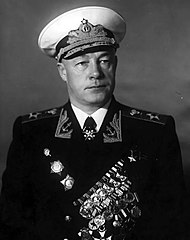 Admiral Nikolay Gerasimovich Kuznetsov (1904-1974) quite critical of Stalin’s rule, preferred to develop technology to require some balance, notably through missiles, and a more defensive policy through good submarines, MTBs and missile FACs. The policy of pursuing the development of a strong conventional force, with mass-produced cruisers (Sverdlov), the new Stalingrad class battlecruisers, and Skoriy class destroyers was immediately suspended after the death of Stalin, shifting towards missile ships as soon as possible.
Admiral Nikolay Gerasimovich Kuznetsov (1904-1974) quite critical of Stalin’s rule, preferred to develop technology to require some balance, notably through missiles, and a more defensive policy through good submarines, MTBs and missile FACs. The policy of pursuing the development of a strong conventional force, with mass-produced cruisers (Sverdlov), the new Stalingrad class battlecruisers, and Skoriy class destroyers was immediately suspended after the death of Stalin, shifting towards missile ships as soon as possible.
The first of these, the “Kynda class” were crude missile platforms designed to attack the USN task force, with nuclear warhead fitted SSNs if needed. Following this, the policy evolved to embrace two new types, the Kresta I and Kresta II dedicated to ASW/AS and SAM warfare, before the ASW Kara class, before a return in the late 1970s to anti-ship vessels such as the Slava class, made to replace the 1960s Kyndas, and ships that were really out of the box. The latter were the Moskva class helicopter cruisers, Kirov class “battlecruisers”, Kiev class cruiser-carriers hybrids.
1 heavy aircraft carrier cruiser
> 1 Kuznetsov-class aircraft carrier
5 Helicopter cruisers
> 3 Kiev-class aircraft carrier
> 2 Moskva-class helicopter carrier
3 battlecruisers
> 4 Kirov-class battlecruiser
28 missile cruisers
> 3 Slava-class cruiser
> 7 Kara-class cruiser
> 4 Kresta I-class cruiser
> 10 Kresta II-class cruiser
> 4 Kynda-class cruiser
24 Conventional Cruisers
> 4 Chapaev-class cruisers
> 20 Sverdlov-class cruisers
cold war doctrine of Soviet missile cruisers
First off, we have to start with the Soviet Typology about their own cold war cruiser lineage, but the denomination below was established in 1949.
KRL
Legkiy kreiser or «лёгкий крейсер» in cyrillic (КРЛ)
These are light cruisers. Basically the whole lineage of WW1 to late WW2 conventional cruisers. It started with the 1912 Svetlana class, and went through the Admiral Nakhimov class, interwar Kirov class (armed with trple turrets and 180 mm guns), and its sub-class Maxim Gorky, very active in WW2. This also included the Chapayev class (answering the wartime large light cruiser type similar to the USN Cleveland class) and the massive post-cold war Sverdlov class.
The development of conventional cruisers stopped after Stalin’s death in 1953 as the Soviet Navy, under the leadership of Admiral Kuznetsov, took a U-turn towards innovative and somehwat disruptive path to compensate for its numerical inferiority towards the USN. A sensible move, as the USSR of that time did not have the capacity to generate a fleet equivalent to the record-breaking US Navy armada, by a long shot.
It should be added that another type called Vspomogatel’nyi kreiser or «Вспомогательный крейсер» (ВКР) were Auxiliary cruisers, 17 liners requisitioned and armed between 1918 and 1922 for the civil war ‘Red’ navy, and a single ship in 1941, Mikoyan (1935), an ex-ice-breaker.
TKR

Tyazhelyi kreiser or «тяжёлый крейсер» in Cyrillic (ТКР)
The heavy cruiser type was developed shortly before the war. In addition to the German heavy cruiser Lützow, gifted at the occasion of the Germano-Soviet pact as Petropavlovsk, she was never completed but fought at Leningrad.
A single class was started in 1939: The Kronstadt class (see in 3D). Both were laid down but BU on slip after the war or blewed up to avoid catpure.
After the war ended, Stalin urged the need for a modernized version of the concept. This development led to the Stalingrad class (Project 82).
The first of the three, Moskva and Arkhangelsk were laid down in 1952, but BU on slip after 1953, as Stalin was not there any more and priority has changed. So this TKR type shoes were never filled.
RKR
Raketnyi kreiser or «ракетный крейсер» in cyrillic (РКР).
The missile cruiser type. This was the main deal of course once Stalin had passed out, as development of missile took quite a boost in the 1950s.
In this guise, there were three classes that were classed as such, performing a generic and specialized antiship function:
-The Kynda, Kresta I and Slava classes.
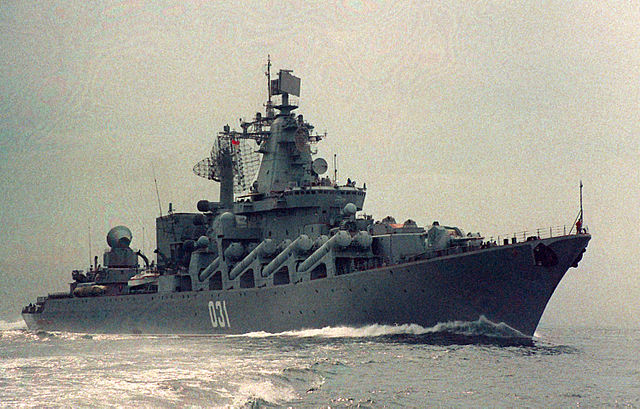
Chervona Ukraina (Black sea fleet Ukrainian flagship) en route for the Pacific via the Suez canal in the 1990s.
PKR
Protivolodochnyi kreiser or in Cyrillic «противолодочный крейсер» (ПКР).
The ASW missile cruiser type. Three types could be assimilated: The Kresta II, Kara and Moskva.
However only the latter was classed officially as “Kreiser” (cruisers) in Soviet service.
Indeed, the Kresta II (10 ships) and Kara class (7 ships) were more of a standard/ASW oriented weapons platform called large ASW frigates in Soviet service, whereas NATO registered them as ASW cruisers (also classed that way in Conways book, and Janes). However the two Moskva were rather large, long range, heavily armed “sub-killers”, enough to be assimilated as cruisers despite their ASW role devoted usually to frigates in Soviet service.
The Moskva class were a class of their own in a sense, close in concept to the Japanese helicopter destroyers, the French Jeanne d’Arc or the Italian Veneto.
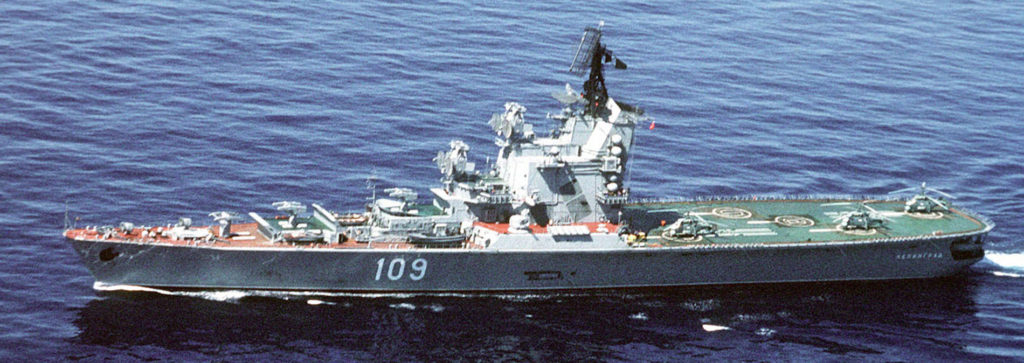
TARKR
Tyazhelyi atomnyi raketnyi kreiser or in cyrillic «тяжёлый атомный ракетный крейсер» (ТАРКР).
These were the original Heavy nuclear guided missile cruisers, later reclassed as Heavy Guided Missile Cruisers (TRKR) in 1997 in Russian era.
They were a class of their own, of course we are talking about the fabled, legendary Kirov class, second of the name.
More on these further down. The class comprised the 1977-89 Kirov (later Admiral Ushakov) Frunze (later Admiral Lazarev, Kalinin (later Admiral Nakhimov) and Yuri Andropov Renamed later Petr Velikiy. The post cold war era was not tender to these behemoths.
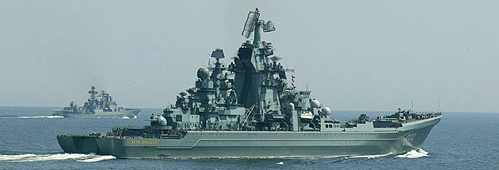
TAKR
Tyazhelyi avianesushchii kreiser or in cyrillic «тяжёлый авианесущий крейсер» (ТАКР)
The Heavy aircraft-carrying cruisers were the most distinctive Soviet large warships of this era. They were unline anything else in any other fleet.
The type was represented by two classes: The famous four Kiev class (Kiev, Minsk and Novorossiysk) and the Kuznetsov class (Tbilissi, Riga). The latter two were much closer to true aicraft carriers, but they retained a substantial hitting power, larger than contemporary supercarriers, hence their denomination of “cruisers”. They were caught by the fall of the USSR and had diverging fates. The 1970s Kiev however were pure hybrids.
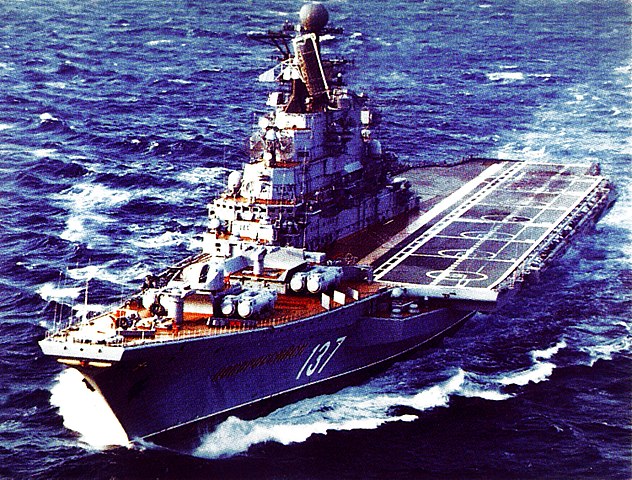
Kirov, Kiev and Moskva classes: Soviet immoderation
As shown by this nomenclature, the Soviet cruiser lineage, at the top of the Soviet Navy, devoid of proper aircraft carriers, denotes a clear difference of doctrine compared to the USN. The latter based its naval supremacy on the task force, which doctrine and strategy was elaborated during WW2 and perfected with its new pivot, the super-carrier. This organization rearranged all other vessels, whether they were missile cruisers or destroyers as “fleet escorts”. This even included massive ships like the nuclear-powered USS Long Beach, the closest equivalent to the Soviet Kirov class that was ever built, although much lighter in terms of armament.
Each task fore was a self-supporting ensemble, able to strike and defend itself on many layers, the farthest being cruise missile and long range interceptors (such as the Vigilante). All-around protection by provided by USN cruisers, AA protection by destroyers, and ASW protection by frigates. This was precisely to disrupt the task force that the Soviet Navy invested much brain power, muscle, money and ingenuity, making it still an attractive subject for historians and amateurs alike (as your servant, which is in constant awe with this subject).
We can see that in all three classes listed above, but it went straight to the Kynda class. These cruisers were advertised as “aircraft carrier killers”. The reality did not lived up the expectation, as their missile reload system was pathetically slow, and the missile themselves quite primitive in essence. But they carried quite a heavy payload, or even a tactical nuclear charge which could have cause havoc if not intercepted. The “carrier-killer” was revived in the late 1980s with the Slava class, which were scheduled to replace them and were much more modern. They carried all their missiles without reloads, and like the first, were strategically spread between each of the four fleets of the Soviet Union. The Kresta class in comparison were much more rounded cruisers, good for any purpose and likely to escort the first.
As for the Udaloy and Sovremenny class, they were (wrongly now) classes as cruisers. But for all authors and in Russian nomenclature thay are registered as destroyers. The confusion came from their early NATO classification, but they logically succeeded to earlier class of destroyers and were quite numerous, as no “missile destroyers” were known to be developed in parallel.
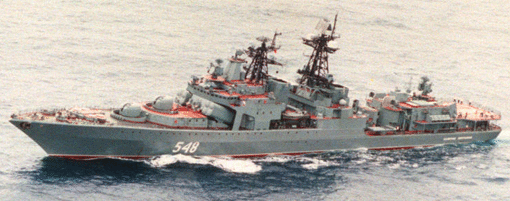
Udaloy class: The 13 Udaloy were as large as the Kara or Kresta types, and versatile ships designed by the Severnoye Design Bureau. However the 21 Project 956 destroyer (Sovremenny) had a specialization as AA ships whereas the 13 Project 1155 (Udaloy) were more large anti-submarine ship. Both were nevertheless a response to the American Spruance class destroyers.
Of the most outlandish trio of this picture was of course, the Moskva class. The first were perhaps innovative of these, ans the earliest. Completed in 1967 they can be compared to the Italian Veneto, the French Jeanne d’Arc and Japanese helicopter destroyer, but Soviet-style: They were far more larger at 14,000 tonnes, 32 meters wide, with a pear-shaped look. The large rear helipad deck, large capacity with fourteen Ka-25 ‘Hormone’ helicopters and powerful armament in a staged superstructure which ended in a mack cut abruptly over the deck 2/3 of their length was quite unique indeed. The range of their helicopters combined with their potentially nuclear depth charges made them superb sub-hunters indeed, that can assume if needed amphibious assault support missions. They were developed at first to “clear the path” of Soviet SSBN from Poliarny, the northern fleet, and had nothing to do with the USN Task forces, but were an auxiliary of Soviet deterrence.

For the Kirov class built later in the 1970s, the objective was simply to upgrade the Moskva design at first, but Project 1143 Krechyet (gyrfalcon) evolved to include an air group. There were proponents in the Navy for an equivalent of the Kitty Hawk super carriers, and the project was started full-deck carrier proposal, Proyekt Orel. The Soviet authorities decided to compromise, and the more cost-effective “heavy aviation cruiser” was developed instead.
The end result was remarkable. The Kiev class carried much more firepower than any super-carrier, and above more escorts in general, as should be a missile cruiser. Each carried indeed 80 to 200 surface-to-air missiles to create an umbrella for its own flying assets to operate, and for the closer bubble, 2 dual-purpose guns, 8 close-in weapons systems and even 10 classic torpedo tubes. Each also carried more helicopters than the Moskva, 16 in all, with the exclusivity of carrying 12 × Yak-38 aircraft. The main problem here, which made them a less attractive proposition, if these planes were at the level of their probable inspiration, the Hawker Harrier. But they weren’t.
Instead, it was hard even for the very secretive Soviet ministry of defence to hide the fact these planes were utter failures. Their complex VTOL capability was barely powerful enough to alow them to fly, moreover to carry any offensive payload, making them pretty useless and a weapon system, not mentioning their abysmal agility and reliability records. In a parralel universe if the Soviet authorities have managed to get their hands on a Harrier and reverse-engineer it, the Kiev potential would have been demultiplied, and the whole proposition cost-effective indeed. Three were built, one for each fleet but the northern one (where the Moskva first operated).
For the next entry in the batch and certainly the most famous, the Kirov class, the Soviet tested a new concept born from intelligence reports over Western advanced ECM and jamming capabilities. It was assumed that in a decade, they would advance so far as to defeat any Soviet missile system in use. Another path was chosen, perhaps inspired by Lenin’s famous quote that “quantity was a quality in itself”. The idea was indeed to orchestrate a saturation fire. This type of ships was clearly created to defeat an American task force, not by striking its flagship, the carrier, but destroying the escort vessels, unable to counter such as massive attack from dozens of vectors at once, in several waves.
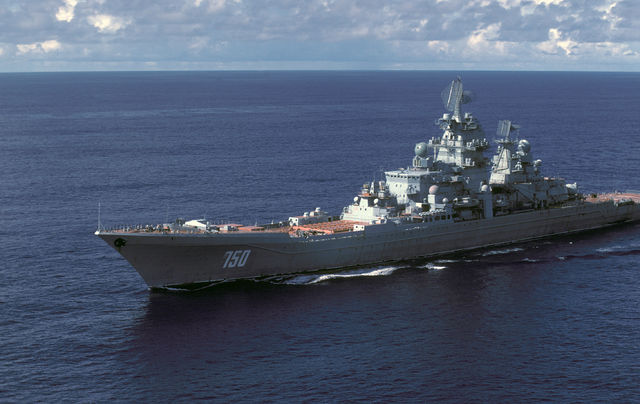
When she was first revealed to NATO in 1981, via satellite and some intelligence data, calling her BALCOM I (Baltic Combatant I), the Kirov came as a nasty surprise. Project 1144 Orlan (sea eagle) became overnight the largest and heaviest surface combatant warships ever built and imposed NATO to review its nomenclature, by default giving them the somewhat old school “battlecruiser” type name.
There has been countless “what-if scenarios” of a confrontation between such ship and any of the USN warship in service and the response was always the same, the Kirov came on top each time. For other, more anachronistic scenarios pitting these ships against WW2 battleships, the picture was no longer clearer as the latter could bring a formidable armour to resist missile impacts. But in the 1980s, the Reagan years, as the cold war suddenly became way colder, these four apocalypse riders shifted the balance in case of an head-on conflict. In fact five were planned initially, but only the first three would be ready before the fall of USSR, the last (launched 1989) being completed much later.
They imposed NATO naval staff to react. It was too late to design and built a USN equivalent, as it would have required years of R&D. It was suggested to rearm, modernize and built sister-ship of the already existing Long Beach, but in their present state they were still inadequate. In 1980, Ronald Reagan, Republican candidate and former actor as soon as he was elected, promised to build up the U.S. military as a response increasing military power in the east. Reagan’s 600-ship Navy policy was to included soon a counter to the Kirov class. After many discussions, the most surprising course of action (but logical in a sense), was to reactivate the four Iowa-class ships. Beyond the astonishing announcement the task of modernizing these 50-years old relics fell to the Navy’s best minds.
The Navy several proposals were considered, notably to convert her as an hybrid, getting rid of her aft 16-inch turret (Martin Marietta proposal) for 12 AV-8B Harrier STOVL, while Charles Myers, a Pentagon consultant, proposed a massive missile vertical launch system instead plus an enlarge helicopter flight deck. Naval Institute’s Proceedings review proposed a canted flight deck for F/A-18 Hornet fighters. All these were dropped in 1984 while it was chosen a simpler a quicker approach: Modern electronics, modern CIWS for close defense and a battery of harpoon cruise missiles. This however still represented an $1.7 billion spending and the process, which started in 1981 was completed in 1988. The cost was the equivalent of four Perry class ASW frigates.
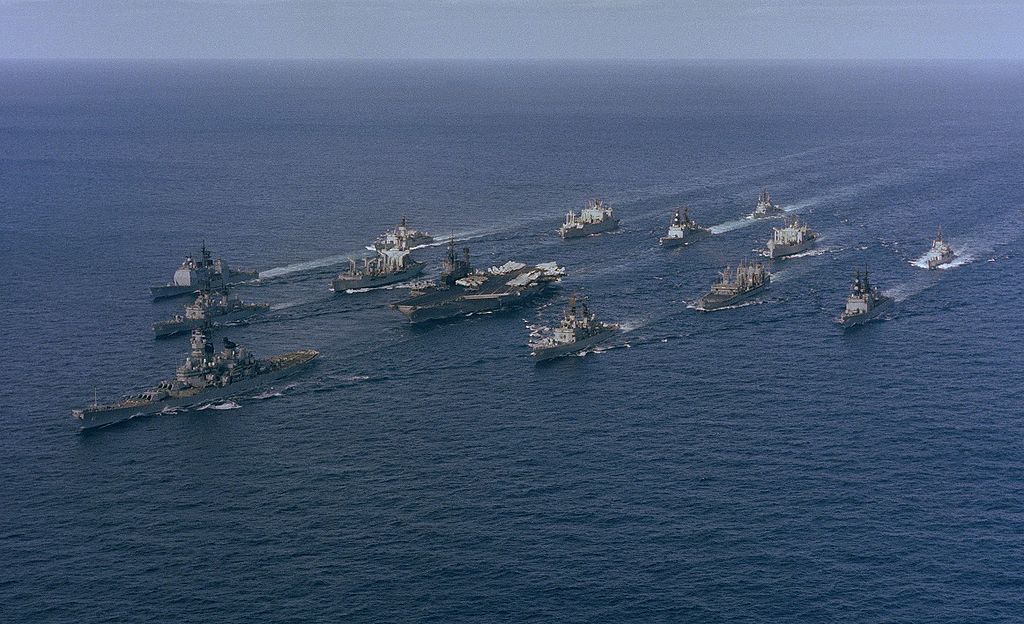
USN Response to the Kirov: Task Group Alpha with the addition of USS Midway underway in 1987.
This reactivation came with tactical changes, as these battleships became the centerpieces of their own battle group (“Battleship Battle Group” or “Surface Action Group”). Each comprised a Ticonderoga-class cruiser, one Kidd/Arleigh Burke missile destroyer, a Spruance-class, three O.H. Perry-class frigates, support ship and fleet oiler. This task force was essentially the same as a carrier force, with the capital ship swapped instead. These new task forces were tailored specifically to deal with the Kirov class.
If the latter was to eliminate part of, or the entire escort, the Iowa still could close in and deliver a deadly punch with its 40 km+ one ton HEAP shells, guided by relay radars and satellites for a much better precision. Against a volley of 16-in shells, the Kirov was as good as a bunch of palette wood. The only passive protection it had was 76 mm of armor plating around the reactor compartment, and light splinter protection…
Soon after, the Soviet Union collapsed and the Kirov class cruisers were pretty much defeated by their lack of maintenance. Nowadays, only Pyotr Velikiy (Peter the Great) remained in service. The two older are in spare parts reserve, to be scrapped in 2021 while Admiral Nakhimov is undergoing a very long refit. On the other side of the pond however, the four Iowa were finally decommissioned and turned into museum ships. There were plans to replace their firepower by the new Zumwalt class destroyers, but this never happened. The Russian cruiser remains unmatched.
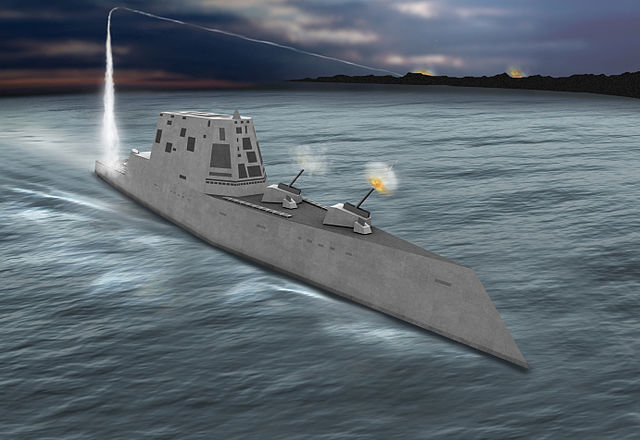
The DDG(X) Zumwalt class should have been the response to the Peter the Great class (ex-Kirov) after the deactivation of the Iowa class. However, the projected electric artillery never was operational and the whole program cancelled by the Congress. No artillery is available to deal with the Russian cruisers, but Trump affirmed the option to reactivate the four veterans was still a valid proposition. USS Iowa, Missouri and New Jersey are now anchored museum ships, while USS Wisconsin has been deactivated and stricken but preserved in 2006. All four are maintained by the USN so to be ready for a reactivation process, just in case.
The last entry on this trio is the most recoignisable for us, and logical step for the Soviet Navy: A fully fledged aircraft carrier class. Both Project 1143.5 Orel (which ended as the Kuznetsov-class “heavy aircraft-carrying cruiser” and Project 1143.7 (Ulyanovsk-class), much larger, would not be completed before the fall of USSR. By all means, and despite their denomination, both were indeed aicraft carrier in overall appearance, but with a massive island, electronics suite, and armament: 12 P-700 Granit (SS-N-19 Shipwreck) anti-ship missiles, 192 3K95 Kinzhal (SA-N-9 Gauntlet) SAMs and for close-in defense, 8 Kashtan CIWS mounts, 6 AK-630 AA guns, and one UDAV-1 ASW rocket launcher. All these could have found their way on a missile cruiser. To this the Orel project carried a supplement of up to 32 aircraft, and the naval staff did not repeated the Kiev error and navalized proven, very capable combat jets: The Mig-29 and Sukhoi Su-33.
They were a STOBAR configuration logical evolution of the Kiev design, their “hybrid” nature being more subtle as shown above. They are not seen here as they changed class to aicraft carrier in the new Russian Navy, where they belong. See also the Project 1153 OREL.
Missile Cruisers in Russia: Any Future ?
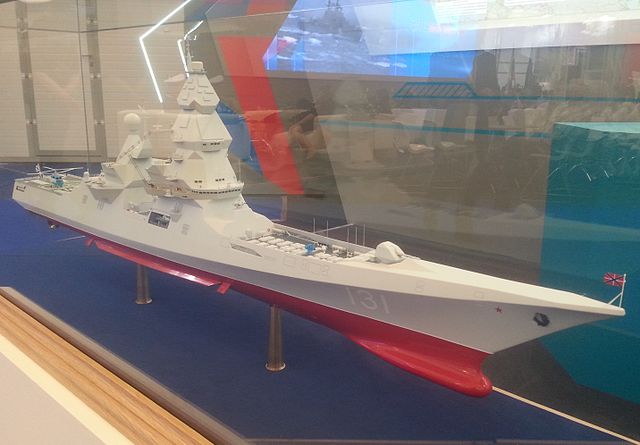
In 2015 was showcased a model of Project 23560 destroyer, at the ‘ARMY-2015’ military technical forum. Better known now as the “Lider class”, the prestige project went through revisions and near-cancellations. By all means, the vessel had all-around capabilities making her closer to the Soviet-era cruisers than a modern destroyer. Designed by Severnoye Design Bureau, and the Krylov State Research Center, the project has evolved into a destroyer, large ASW ship and guided missile cruiser all meshed into one package, and allegedly better armed than the Kirov class.
It should be said the general appearance of the ship was equally impressive -as her mensurations- 19,000 tons, 230 m x 20 m x 6.6 m, about 200 missiles and powered by a nuclear reactor and capable of 32 knots. It is indeed nowadays the only modern inheritance of the soviet era missile cruisers, and a clear statement of a return to the prestige of the Soviet fleet. No order was made yet, but planned for 2023. Future will tell.
Nomenclature of Soviet cruisers
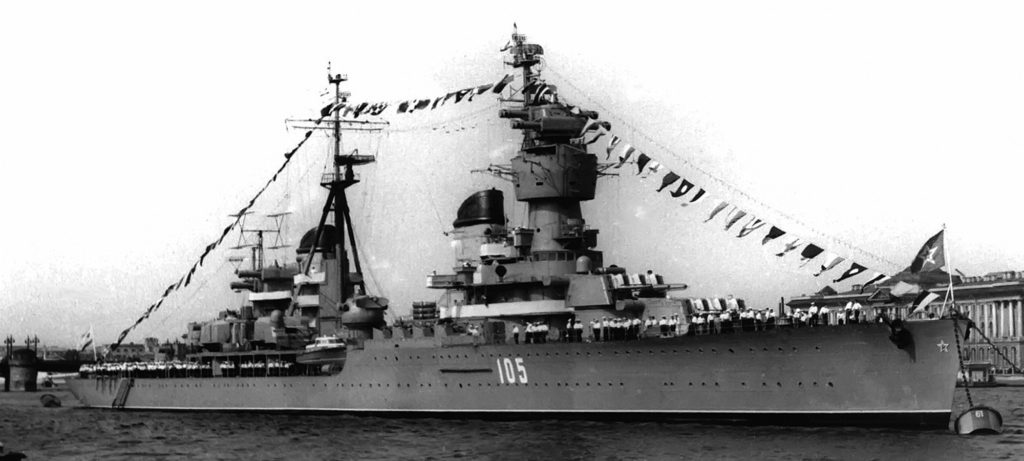
These large ships succeeded the heavy cruisers of the Maxim Gorky class (1938). They were different from the two late units of this class, released in 1943 and largely improved. The Chapayev are much larger, with the addition of 5000 more tons. They were in fact the first heavy cruisers designed completely out from the old Italian influences started with the two Kirov of 1935.
They sacrificed nominal firepower (150 mm guns instead of 180 mm), to integrate an additional turret, carrying three more guns, to go for a twelve guns battery, as for the American ships of the Cleveland class. However, in category, they rank undoubtedly in the “heavy” class, and even near the top of it.
They were well served by a powerful AAA, according to wartime lessons, were further modified along the way to reach more firepower. Secondary armament consisted of eight traditional twin mounts giving way ultimately to four twin turrets, 130 mm caliber, reaching the Soviet fleet standards of 1960.
There will actually be 8 ships in this program, whose design dated back to 1936. But the first four ships launched during the war, the Chapayev, Zhelezniakov and Frunze in 1940, and the Kuibyshev in 1941 were never completed. With the advance of the Wehrmacht, two were captured and later modified, while the others experienced various fortunes.
The Chapayev was completed in 1949, like Zhelezniakov, and Chkalov, and Frunze and Kuibyshev in 1950. The Ordzhonikidze and the last ship of the class ordered but was never completed. These ships carried two seaplanes originally (replaced by radars after the war) and were tailored and equipped to lay more than 200 mines.
Chapayev class cruisers were in service in 1960. However the dates were they were stricken from the fleet list is unknown: Chapayev is believed to have been retired 1961, as Frunze or 1962, and the Kuibyshev. Chkalov and Zhelezniakov were however maintained in service until 1990 as training ships. With the decomposition of the Soviet Union, no doubt they were mothballed and left to rot. None was preserved.

Komsomolets
SPECIFICATIONS
Displacement: 11,300t, 15,000t FL
Dimensions: 201 x 19.70 x 6.40m
Propulsion: 2 turbines , 6 boilers, 130 000 hp = 34 Knots
Crew: 840
Armour: 50 – 80 mm (3.8 in), CT 152 mm (6 in).
Armament: 18 x 150 (6 in) (4×3), 8 x 2 AA 100 mm (4.6 in), 24 x 37 mm, 6 533 mm TTs (21 in) (2×3).
 Sverdlov class cruisers (1951)
Sverdlov class cruisers (1951)
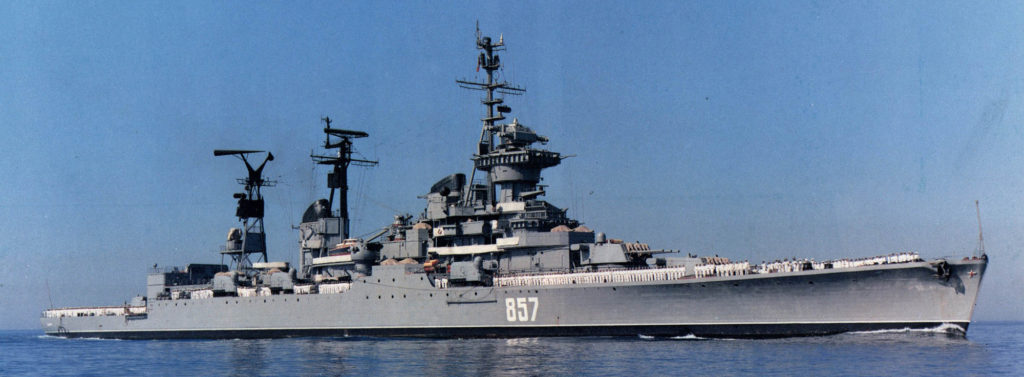
The Sverdlov class cruisers were the last soviet conventional cruisers. They succeeded the Chapayev launched at the beginning of the Second World War.
This massive class wanted by Stalin was to answer the armada of American cruisers of the Cleveland and Baltimore classes. A total of 50 ships were planned to give the USSR a definitive supremacy. But this unrealistic figure was quickly reduced to 24, and then 20, which were actually started between 1949 and 1955 at the shipyards of the Baltic, admiralty yards, Nikolayev and Severodvinsk. This was completed by amazing plans for the Stalingrad class battlecruisers.
The death of Stalin
The death of Stalin had these plans completely scrapped. The idea of a classic battle fleet at the insistence of the Kremlin’s master, which had the same appeal perhaps to Hitler in terms of delusional grandeur, was no longer the priority of the day.
Instead, Khrushchev, well advised by the new head of the Soviet admiralty, had less ambitious plans, but more practical and a realistic, pragmatic approach for innovative solutions to deal with the US Navy supremacy, rather than trying to cope in numbers on the same level. This became the first steps for a new policy which endured until the 1980s.
Of this total of twenty, two of these cruisers never even reach the launching stage, being cancelled and broken up along the way, and four more were never completed and remained anchored in the Neva estuary in Leningrad until 1961. Only 14 cruisers were finally completed between 1952 and 1955.
Sverdlov class design
The Sverdlovs were much like the Chapayevs, but had greater autonomy thanks to larger hull dimensions allowing the installation of generous oil tanks. They also had a better overall protection, with a double hull on 75% of her length, and 23 watertight compartments.
These cruisers inaugurated new radars and fire control systems, plus new 100 mm mounts for their secondary batteries, copied from the German dreaded 88mm Flak battery, also used on the Skoriy class destroyers. The 152 mm (6 in) main turrets were improved versions of the Chapayev ones. The final, revised design was adopted in May 1947. In 1960, these ships were already outdated in the face of missile warfare.
Career and fate of the Sverdlov class
Some of these ships were then converted (as the Americans had done) into missile cruisers. Thus, Admiral Nakhimov was rebuilt barely two years after entering active service as an anti-ship missile cruiser, equipped with AS-1 missiles, then SS-N-1 “Scrubber” missile, using a replacement launcher at the same time. She also kept half the turrets. This conversion proved a disappointing one, and the ships was eventually used as a target and then scrapped in 1961.
Dzerzhinski was equipped instead of three turrets and a SA-2 “Guideline” SAM was installed. It was a navalized version of the land launcher. This time the conversion proved a success and she had a long active career, being retired in 1989.
Zhdanov and Senyavin served as command ships, being completely rebuilt in 1970-72 in this role. They received a lattice mast supporting very powerful Vee Cone antennas, satellite relay, the whole rear part being converted into a flight deck for three ASW helicopters, complete with a with hangar, and a retractable missile launcher SA-N-4 “pop-up” plus antimissile superfast 30mm guns.
Revolutsiya, Ushakov and Suvorov received a new enlarged footbridge and more modern electronic equipments in 1977-79, yielding their 3 7mm guns and Egg Cup firing control systems for four 30 mm missile-controlled guns by NATO “Drum Tilt” system.
The Sverdlov class comprised the Sverdlov, Zhdanov, Admiral Ushakov, Admiral Senyavin, Alexandr Suvorov, Dmitri Pozharski, Ordzhonikidze, Alexandr Nevsky, Admiral Lazarev, Dzerzhinsky, Admiral Nakhimov, Mikhail Kutuzov, Oktyabrskaya Revolutsiya, and Murmansk. They were equitably divided among the four fleets.
Orzhonikidze was sold to Indonesians in 1962 as KRI Irian. She Sold for scrap to Taiwan in 1972. Nakhimov was written off in 1961, the others in 1987-89. There were still three of these cruisers in service in 1990: Suvorov, Senyavin, and Murmansk. They were retired in 1990-92, with no budget and no use to support them.

Sverdlov
Specifications
Displacement: 13,600t, 16,640 FL
Dimensions: 210 x 22 x 6,9 m
Propulsion: 4 shafts, 4 turbines, 4 HP boilers, 110,000 hp; 32,5 knots.
Crew: 390
Armour: 50 – 80 mm (3.8 in), CT 120 mm (4.7 in).
Electronics: Radars: Sea Gull, Knife Rest A, Slim net, Top Bow, Egg Cup, hull passive sonar.
Weaponry: 12 x 152 mm (4×3) (6 in), 12 x 100 mm (6×2) AA, 32 x 37 mm (16×2) AA, 10 x 533 mm TTs (2×5) (21 in).
The four Kynda class units were the first Soviet missile cruisers. They were from the outset (1956) designed to respond to American aircraft carriers by another more modern means than that hitherto maintained by Stalin, a line fleet. In addition, they inaugurated a system of launching a “volley” of 8 long-range cruise missiles (250 nautical miles) SS-N-3 “Shaddock”, with recharging of 8 other vectors stored in containers just behind, in the superstructure. However, these reloading operations were long and delicate, also requiring acceptable sea conditions.
These SS-N-3 vectors, capable of implementing a tactical or conventional nuclear warhead, but were dependent on guidance en route and final by Tupolev Tu-95 “Bear-D”. This armament was supplemented by a SA-N-1 “Goa” missile launcher at short and medium range, with a reduced stock (16 vectors) and a very relative effectiveness. This panoply was completed by two AA guns and four rapid fire anti-missiles. The ASW defense consisted of two triple benches of acoustic torpedo tube launchers, and 2 rocket launchers of the RBU 6000 type with 12 vectors each, and vertical reloading. Each rocket had a HE load of 75 kg. automatically adjustable and exploding by magnetic proximity, the coordinate calculations were entirely managed by an electronic console taking its information from the hull sonar. This ASW defense was complemented by a Kamov Ka-25 “Hormone” helicopter, with a stern decking sport, but no hangar, which was a major problem on mission.
Finally, the propulsion was done by a new system (like the contemporary Kashins) of turbines powered by four overcompression boilers. Due to the reduced hull size, this propellant was able to give them a speed of 34 knots. Despite these reduced dimensions, the four Kyndas, started in Zhdanov in 1960-61 and completed in 1962-65 were classified as missile cruisers (RKR). Class: Grozny, Admiral Fokin, Admiral Golovko, Varyag. The Varyag was used in the Baltic, the Golovko in the Black Sea, and the other two in the Pacific. In 1990, all four were active: They were retired from service in 1990, 1991, and 1993.

Kynda class
Specifications
Displacement: 4400t, 5600t FL
Dimensions: 141.7 x 16.8 x 5.30m
Propulsion: 2 shaft turbines, 4 HP boilers, 100,000 hp. 34 knots.
Crew: 390
Electronics: 2 Don-2, 2 Head-net A / C, 2 Scoop Pair, Peel group, Owl Screech, 2 Plinth net, sonar Herkules, 3 CME Bell, 4 Top hat.
Armament: 2×4 SSN-3 (16), 1×2 SAN-1 (16), 4 x 76 mm (2×2), 2×3 533 mm TTs, 2 RBU 6000 ASWRL (24).
The missile cruisers of the Kresta I class (Project 1134) were four originally anti-ship buildings (built 1964-69), intended to succeed the Kynda. They were reclassified early as ASM cruisers, while retaining their planned anti-ship missiles. In any case, they were better able to survive than the Kynda thanks to their secondary armament of self-defense more than doubled. The planned missiles, of the SSN-12 type were still at the stage of developments in 1964, also it was the old SSN-3 which replaced them in series. in addition, the Kresta I were the first Soviet ships to have a helicopter hangar – for a single Ka-25 “Hormone”.
A Kresta I class building in the White Sea in March 1970. Class: Admiral Zozulya, Vitze-Admiral Drozd, Vladivostock, Sevastopol. They were serving in the Black Sea, the Drozd being equipped with four Gatling anti-ballistic missile guns behind the SSN-3 ramps, Zozulya being similarly modified in 1990. In 1990, all four were active: but that was their withdrawal. of service, for Drozd and Sevastopol and 1991 for Vladivostock. The oldest, the Drozd, remained in active service until 1996. But his general condition was so bad that he never went to sea again and was stricken from the lists.

Kresta I general appearance
Specifications
Displacement: 6000t, 7500t FL
Dimensions: 155 x 17 x 5,50m
Propulsion: 2 shafts DGC turbines, 4 heaters, 100,000 hp. and 34 knots max.
Crew: 380
Electronics: 2 Don Kay Radars, Big Net, Don-2, Head-Net C, 2 Plinth Net, 2 Peel Group, 2 Muff Cob, 2 Bass Tilt. Sonar Herkules, 8 CME Side Globes, 4 Bell.
Armament: 2×2 LM SSN3, 2×2 LM. SAN1 (44), 4 57mm (2×2) guns, 10 TLT 533mm (2×5), 2 ASM RBU 6000 LR, 2 RBU 1000, 1 ASM Kamov Ka-25 Hormone helix.
The Kresta II class missile cruisers (Project 1134A, or Berkut A) were like the Kresta I anti-ship cruisers re-evaluated as ASW cruisers when the design was still ongoing. Their armament, to differentiate themselves from the first Kresta I, consisted in 8 new SSN-9 short-range anti-ship missiles. But what was planned was not realized due to lack of technical maturity, and they were replaced by 8 SSN-14 “Flint” ASW systems (with optional tactical nuclear warhead of 10 Kt).
They also had a new bow sonar. Finally, their anti-aircraft missile ramps were the modern SA-N-3 “Goblet”, capable of receiving a tactical nuclear warhead (27 Kt) to disrupt high altitude bomber formations. In addition, four Gatling-type Antimissile rapid-fire guns were adopted from the start. They had a better 3D radar, the new Top Sail (NATO code), more effective than the Kresta I Head Net-C/Big Net suit.
Their hull was narrower, longer, shallower, less heavy from 1000 tonnes. On the other hand, their general configuration was hardly different and the Kresta I and II are often assimilated as a single class. They were made to operate with a “leader” Kresta I unit, possessing long-range SSN-3 “Styx” nuclear warhead vectors.
Class: Kronstadt, Admiral Isakov, Admiral Nakhimov, Admiral Makaorov, Admiral Voroshilov, Admiral Oktyabryskiy, Admiral Isashenko, Admiral Timoshenko, Vasily Chapayev, Admiral Yumashev. They were distributed in Baltic (2), Arctic (5), and Pacific (3). In 1990, all ten were active: They were removed from service in 1991, 1992, and 1993.

Kresta II general appearance
Specifications
Displacement: 5600t, 6556t FL
Dimensions: 159 x 16.8 x 5.32m
Propulsion: 2 shaft 2 DGC turbines, 4 heaters, 91,000 hp. and 32 nodes max.
Crew: 343
Electronics: Speed Cameras 2 Don Kay, Don-2, Head-Net C, Top Sail, 2 Head Lights, 2 Peel Group, 2 Muff Cob, 2 Bass Tilt. Sonar Bul Nose, 8 CME Side Globes, 7 Bell Series.
Armament: 2×4 LM SSN14, 2×2 LM SAN3 (48), 4 x 57mm (2×2), 10 TLT 533mm (2×5), 2 LR ASM RBU 6000 (144), 2 RBU 1000 (60), 1 ASM Kamov Ka helicopter -25 Hormone.
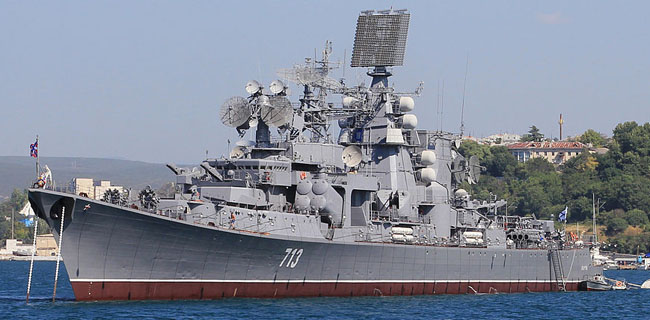
The Kara class missile cruisers were seven rather versatile ships (1969-76), destined to succeed the Kresta I and Kresta II. They had a tactical anti-ship capability with SSN-14 conventional or nuclear missiles, good short range anti-aircraft capability with their two SAN-3 and 4 (72 and 40 vector) missile launchers, their 4 rocket launchers RBU 6000 and 4000 (144 and 60 vectors) and their torpedo tubes. Gas turbines combined with diesel engines were quieter and less vibration-intensive than the Kresta. The last of these ships, Vladivostock (formerly Tallin), built like the others at Nikolayev, was operational in 1980. Class: Nikolayev, Ochakov, Kerch, Azov, Petropavlovsk, Tashkent, Vladivostock. They served in the Black Sea, cruising in the Mediterranean, but two, Petropavlovsk and Tashkent, were sent to the Pacific fleet as early as 1979. The Nikolayev and Tashkent were removed from the lists and kept in reserve in 1992. The others were in service in 1997.

Illustrator’s rendition of the Kara class
Specifications
Displacement: 6700-7630t, 8565t FL
Dimensions: 173.5 x 18.50 x 5,32m
Propulsion: 2 propellers, 4 DGC turbines, 120,000 hp. and 32 nodes max.
Crew: 380
Electronics: Radars 2 Don Kay, 1 Don 2, 1 Top Sail, Head-net C, 2 Head Light, 2 Pop Group, 2 Owl Screech, 2 Bass Tilt. Blue Nose Sonar, Mare Tail, 8 CME Side Globes, 2/4 Rum Tub.
Armament: 2×4 miss. SSN14, 2×2 miss. SAN3, 2×2 miss. SAN4, 4 x 76mm (2×2) guns, 4 AM 30mm Gatling guns, 10 TLT 533mm (2×5), 2 ASM RBU 6000 LR, 2 RBU 1000, 1 ASM Kamov Ka-25 Hormone helicopter.
 Moskva class helicopter cruisers (1967)
Moskva class helicopter cruisers (1967)
Moskva, Leningrad
pic
The Moskva and Leningrad were the first aircraft carriers produced by the Soviet Union. They were perfect hybrids, combining the firepower of a front cruiser and a rear flight deck, a configuration that was quite common at the time, since the Italians did the same for their Doria, and later their Veneto, or the Japanese with their Haruna.
They were specialized ASM warships specifically dedicated to the destruction of American and British SSBNs. So they had to be able to implement big ASM patrol and fight helicopters, having a better range of action like Mil-Mi14 “Haze”. Their pay ranged from 20 to 12 helicopters, two of which had to be on patrol flight for maximum efficiency.
Admiral Gorshkov initialed the specification in 1959, but the latter insisted on the hull as narrow as possible (for speed), the office replying that it would pose insoluble problems of stability, capital for this type of buildings (Gorshkov proposed for a moment the reconversion of one of the hulls of mass cruisers of the Sverdlov class). The cahier des charges was definitively adopted in 1960, opting for a large, large building, very heavily armed for its own defense, notably ASM.
But the studies continued and it was the 23rd project which was definitively adopted in 1961. This last allowed the ship to operate 14 rotating wings, of which a majority of Kamov Ka-25 and Mi-14, by a sea of force 6- 7. They were housed in a shed located between the two chimneys, and the large lower shed, accessing it by two elevators. There were four spots.
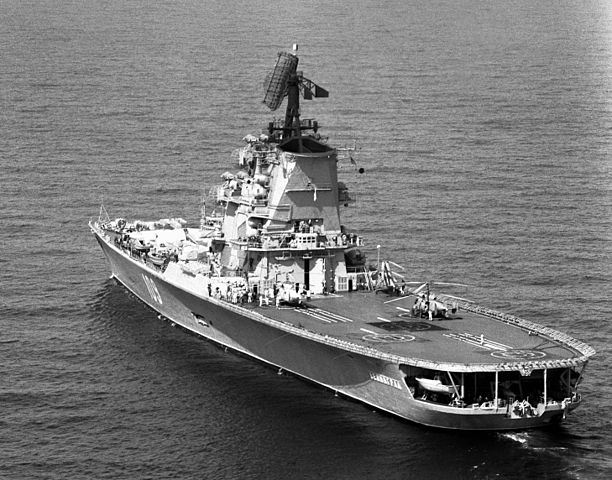
Dod Leningrad
In the meantime, NATO’s SSBN’s Polaris missile range had doubled, forcing Krushchev to review the Soviet ASM defense: The radius of action of the ship and its on-board aircraft was to increase. Twenty-six other modifications were made to the plans before the Moskva was sailed at Nikolayev in December 1962. It was launched in January 1965, completed in December 1967, the tests having officially begun in August 1967.
The Leningrad replaced it in the darse January 15, 1965, was launched in July 1968 and completed in 1969. They inaugurated the gas turbines adopted later, but experienced a number of technical problems more or less serious (until the fire of the Moskva in 1973). They could sustain 24 knots for 3 hours, but were at high risk of attempting spikes at 30 knots (which were only reached at trials).
In addition, their hull was finally quite thin, thanks to the “Y” shape of their sections, which allowed them a good hydrodynamics, but the stability in the heavy weather was to be reviewed. As a result, their torpedo tubes were removed in 1974-75.
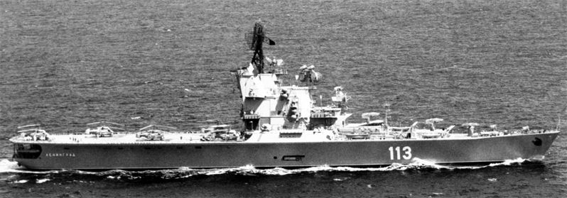
They were both based in the Northern Fleet, but they also “cruised” in the other fleets. Relatively imitated because of their fleet, their defects were taken into account for the new Kiev in 1968. They served until 1990. In 1991, the Leningrad was withdrawn from service and removed from the lists, the Moskva remaining active in 1995.

Author’s illustration of the Moskva
Specifications
Displacement: 11,200t, 17,500t FL
Dimensions: 189 x 23 x 8.5 m
Propulsion: 2 propellers, 2 VHP turbines, 4 HP heaters, 100,000 hp. and 31 nodes max.
Crew: 850
Electronics: Top Sail Radars, 2 Head Light, Head Net-C, 2 Muff Cob, 2 Don-2, 1 Moose Jaw Sonar, 1 SPV Mare Tail, 8 CME Side Globes, 8 Bell, 2×2 Lance Lures.
Weaponry: 2×2 miss. SAN3 (44), 4 (2×2) 57 mm, 1×2 miss. SUW-N1 (12 miss.), 2 LR RBU 6000, 10 TLT 533 mm, 12-14 Helicopters.
 Kiev class carrier-cruisers (1972)
Kiev class carrier-cruisers (1972)
Kiev, Minsk, Novorossiysk, Admiral Gorschkov
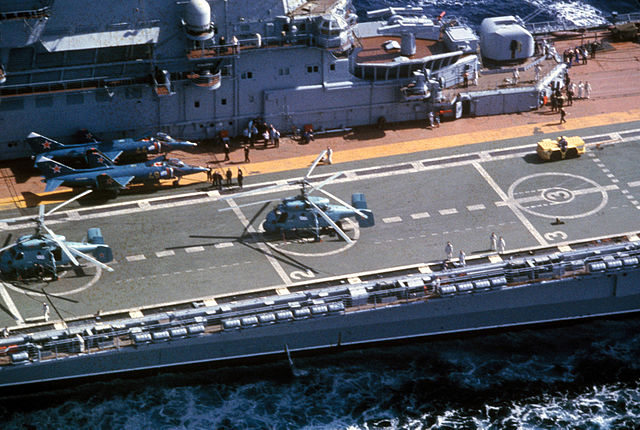
With the 4 Kiev, the Soviet Navy entered in chief admiral Groshkov’s symbolic pet project, destined specificically to project power from the numerous firndly bases and facilities around the world at that time, the ability to be present on all seas, and willing rival to the overwhelming US Navy superiority by using unconventional responses. The Kiev, Minsk, Novorossiysk and Admiral Gorshkov, launched in 1972, 75, 78 and 1982, were completed in 1975, 78, 82 and 1987. They were defined at first as “guardians” of the Delta-type SSBNs, departing on mission from Northern (Arctic) Fleet bases, guaranteeing the destruction of NATO ASW assets in case of conflict.
They, like the Moskva, had to operate a number of ASW helicopters, and also to use interceptors and their own powerful weaponry to destroy allied long range patrol planes (Breguet Atlantic, Lockheed P3 Orion, Bae Nimrod). Capabilities of ASW warfare were impressive, but AA and antiship armament was not sacrificed either and still were quite impressive, on the level of a powerful missile cruiser. The Kiev were already gearing for saturation fire tactic and leaning towards the Kirov class battlecruiser concept.
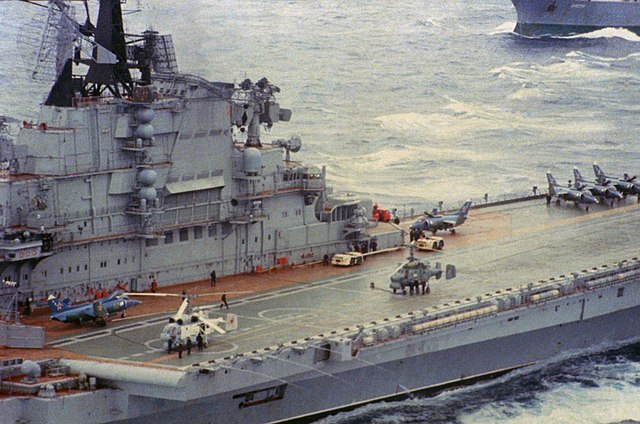
Unlike American aircraft carriers, these Soviet ships are not pure cruisers, nor are they authentic aircraft carriers, but hybrids. Aircraft required a particular flight deck, which is differentiated from the Moskva by being lateral, the superstructure spreading along its length. This was a typical configuration for hybrid ships, which were very rare. The Kiev emerged as quite unique piece of hardware, unline anything in the world.
The entire hull forward section, was that of a missile cruiser, with a complete panoply to meet all needs: Long-range antiship missiles, medium and short range SAMs, ASW torpedo tubes, AA/DP guns, and 3 ASW rocket launchers, plus a carrying capacity for 31 aircrafts, including 12 Yak-38 VSTOL jets and 18/19 Kamov “Hormone” ASW helicopters. The latter could deploy light anti-ship missiles and tactical nuclear ASW depht charges. The Yak 38 was the Soviet replica of the Harrier but is considered a mediocre attempt at best and was discarded perhaps even before the fall of the USSR.
These impressive ships were indeed handicapped the use of these poor quality jets. They would have been capable of intercepting approaching patrol planes just in the range of SAMs, wheres they would have been intended as providing a much longer range cover. The Yak-38 “Forger” (NATO code), were in the opinion of all the experts, and the Soviets themselves (the pilots among others), pale copies of the British Harrier, devoid of surface radar, slow, unwieldy, with a very limited carrying capacity, low range, and nozzles systems difficult to control: There were probably scored of accidents never officially revealed, but the “Forger” quickly gained a reputation of a flying coffin, in stark contrast to the Harrier. It was rushed to production and did not enjoyed the development time of the British Harrier, an amazing success story of British Aerospace industry during the cold war.
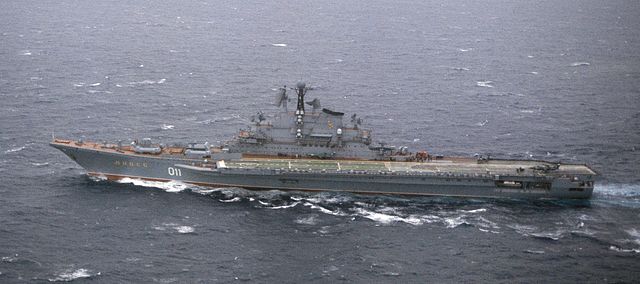
In 1991, the two Kiev-class ships remaining in service were to be scrapped. By then, two were sold to China to serve as “museums” while a third was scrapped and a fourth sold to India, becoming the INS Vikramaditya. Rreplacements for the Yak-38, the Yak-141 “Freehand”, supersonic and with better characteristics was undergoing tests when the Soviet Union started a wave of massive budgetary cuts. The Yak 141 was never operational and sank into oblivion.
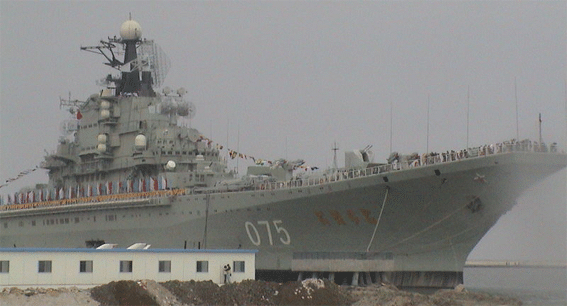
The 4 Kiev were still in service in 1992, but both of the Pacific Fleet have been stranded since their respective propeller accidents in 1994 due to lack of funds for repairs, and both of the Northern Fleet suffered a small fate. enviable: In order to keep the Gorshkov in service, the Kiev was cannialized, and then docked and disarmed.
The Gorshkov was the only one active for some time, but she was often docksided due to the lack of funds for her maintenance. She was moored in Kiev, and by the late 1990s her general state was closer to that of a wreck. The Russian navy has given priority to the Tbilisi. The Kiev and Minsk were sold to China to serve as “museums” in 1995-96. One was converted into a muxury hotel, while the Minsk was relocated in Nantong awaiting reuse at planned theme park.
Novorossiysk was scrapped at Pohang in 1998 and Admiral Gorshkov was sold to India in 2004, becoming the INS Vikramaditya. This ship was comprehensively rebuilt in Severodvinsk along the lines of the Russian aircraft carrier Admiral Kuznetsov, and entered into service in 2013 as flagship of the Indian Navy.
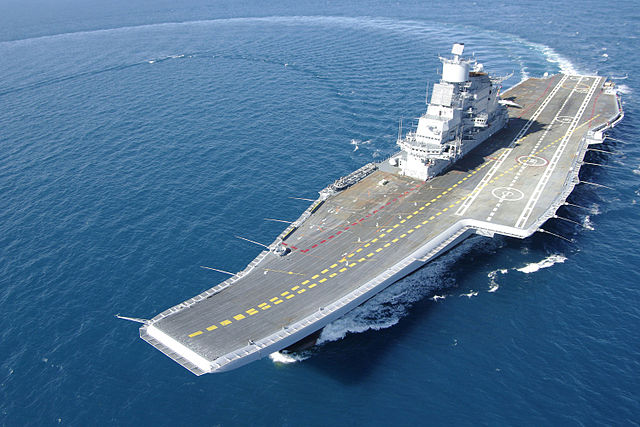
INS Vikramaditya during trials in 2013. She completed her impressive transformation from an hybrid missile cruiser to full-blown aircraft carrier.
Kiev class Specifications
Displacement: 36 000t, 42 000t FL
Dimensions: 275 x 32,7(47,2 PE) x 8,2m
Propulsion: 4 propellers, 4 turbines VHP, 140 000 cv. et 32 knots max.
Electronics: Radars 2 Palm Front, Top Sail, Top steer, 2 Head Light, 2 Pop group, 2 Owl Screech, 2 bass Tilt, 1 Trap Door.
1 prow passive sonar, 1 SPV, 8 CME Side Globes, 12 Bell, 4 Rum Tub, 2×2 flare launchers.
Armament: 4×2 SSN14 (24), 2×2 SAN3 72), 2×2 SAN4 (40), 4 x 76 mm (2×2), 8 x30 mm Gatling, 10 x 533 mm TTs (2×5), 1×2 LR SUW1, 2 RBU 6000 (2×12)
On board aviation: 12 Yak-38 jets, 19 ASW Kamov Ka-25B/C “Hormone” helicopters.
Crew: 380
 Kirov class battlecruisers (1977)
Kirov class battlecruisers (1977)
Kirov, Frunze, Kalinin, Yuri Andropov
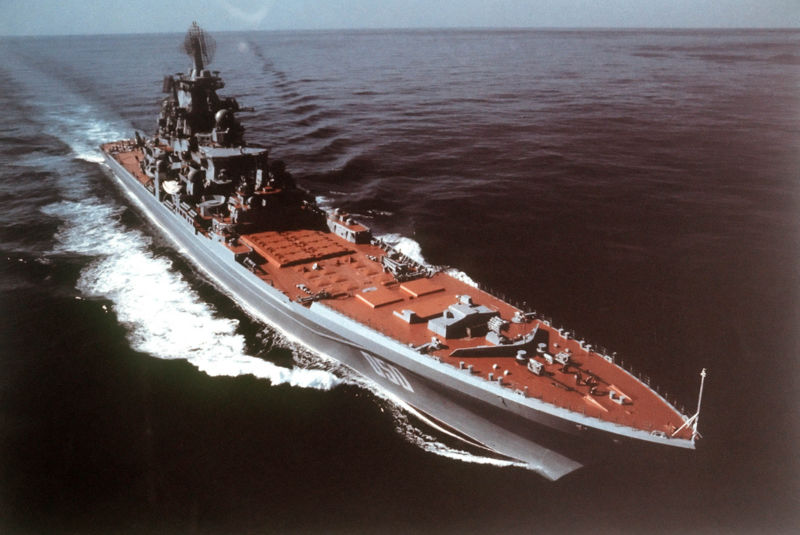
Battlecruiser Frunze
The Kirovs are like the Kiev another originality of the Soviet navy during this era, perhaps one of the most recoignisable trademark offered to the world. Unmatched missile cruisers, by ay standard, these four units were the most powerful surface units ever built in the 1980s. They were tailored to obviously oppose an air strike force from an aircraft carrier, and the carrier themselves and their escort by using saturation fire. Unlike the battleships of old, missile cruisers have no active protection, except for subdivision below the waterline. Lucky hits in the electronics could be fatal, although the Soviets always planned manual and optical bakcups for just such as case.
Compared to the Iowa-class moderized and reintroduced in service, their delicate electronic equipment would succumb to even medium-caliber impacts. But the protection of a Kirov is above all active: Long-range cruise missiles and 2-3 successive layers of protection on long and medium range, close range missiles, ECM and powerful short-range jamming systems were all geared towards protecting the ship and its own task force, as a capital ship.
The Kirov had all the current panoply of a missile cruiser, but on a gargantuan scale. NATO, on the fait accompli, had to note the existence of these ships for which the term “cruiser” seemed inappropriate: Immediately, experts agreed that the title of “battlecruiser”, a category that was thought extinct since the Battle of Jutland, was a good match.
Indeed, commonalities were obvious: Endowed with a very large firepower, worthy of a ship of the line but in a missing category, these ships only rely on the range and variety of their arsenal to deal with all threats. Many experts have emphasized its de facto “invulnerable” nature and pointed she was a clear naval superiority vessel.

When the second vessel, Frunze, was accepted into service in 1984, the US navy under the Reagan administration, had given up the prospect of building equivalent ships, although the USN dreamed of it. Rather he found a rather surprising compromise solution: The return into service of the four veterans of the second world war of the Iowa class. These battleships were completely rebuilt and modernized, armed with cruise missiles and state-of-the-art equipment to deal with modern threats.
This choice may seem surprising, but was considered very rational: Updated, the Iowa combined the capabilities of a modern missile cruiser and conventional big-gun armament, were fast, and contrary to all ships of the time, had a level of armor which was though nearly invulnerable to conventional missiles. In any case a nine hard-cased shell volley did not not feared any interferences, lures and antimissile vectors, or even fragmentation shots. In short, the Kirov class, ultimately four units (Kalinin in 1988 and Yuri Andropov by 1990), found their most serious antagonists.
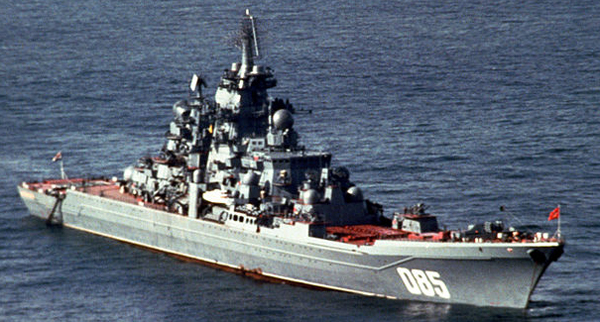
Kalinin 1991
The Kirovs, in addition to their impressive missiles range, most of them in silos forward, used a mixed propulsion, Nuclear and steam combined, with two nuclear reactors, a solution that the US Navy had studied a time and rejected because of its complexity. On a single reactor, the Kirovs already reached 24 knots, and 30 by combining this with high pressure turbines. The idea of nuclear-powered cruisers dated back to 1968 in USSR.
The design of the Kirov was finally approved in 1971, and the first was started in 1974, followed by the other three, in the same basin of the Baltic shipyards in Leningrad. The team led by Admiral Gorshkov settled on a ship design named “Orlan”, dispacing 8,000 tons at the most. But new studies amidst requirements eventually led to a new and more realistic standard of 20,000 tons.
The Kirov were conceived, thanks in particular to their non-standard dimensions, like command ships for the fleet, with ad hoc equipments. One of them was to be assigned to the Baltic, another to the Northern Fleet, and the other two for the Black Sea fleet and the last to the Pacific Fleet.

Piotr Velikiy
Although not armored, these ships had a protective armored layer of 100 mm above the reactors, and 35 to 75 mm plates elsewhere. They differed between each other regarding their electronic equipment, and superstructure details, due to rapid development of electronics and building span. A fifth unit, Dzerzhinsky, was planned for 1995 and started in 1989, but the order was canceled and she was disassembled in situ. More advanced but mothballed on the 1990s she would have been laikely purchased by China. Currently these four ships are still on the lists of the Russian Navy. They are undeniably the flagship.
With the fall of the USSR, these ships were renamed Admiral Ushakov, Lazarev, Nakhimov, and Petr Velikiy (Peter the Great). But their situation was hardly brilliant: The first two were temporarily removed from service for lack of fuel and maintenance. Nakhimov suffered from a reactor accident in the Mediterranean in 1990, her turbines failed and later repairs dragged for years due to the state of the Russian economy. Eventually all but Peter the Great (admiral ship of the northern fleet) were retired from service: Admiral Ouchakov in 2001, Admiral Lazarev and Admiral Nakhimov in 1999.

Author’s Illustration of the Kirov class
Admiral Ushakov-heavy atomic “Eagle”.
by The_Ping Pro
on Sketchfab
Kirov class Specifications
Displacement: 24 000t, 28 000t
Dimensions: 248 x 28 x 7,5m
Propulsion: 2 propellers, 2 turbines NVC, 150 000 cv. et 32-34 Noeuds max.
Crew: 800
Electronics: Radars 2 Palm Front, Top Sail, Top steer, 2 Head Light, 2 Top Dome, 2 Pop group, 2 Eye bowl, 4 bass Tilt, 1 Punch bowl. 2 Sonars Horse Tail et Horse Jaw (SPV), 8 CME Side Globes, 10 Bell, 4 Rum Tub, 2×2 Lance leurres.
Armament: 20x SSN19, 1×2 SSN-14 (16), 12x SAN-6 (96), 2×2 SAN-4 (40), 4x 100 mm (2×2), 8x 30 mm CIWS, 2×4 TT 533 mm, 2×6 LR RBU1000, 3 ASW Kamov Ka-32 Helix.
 Slava class cruisers (1979)
Slava class cruisers (1979)
Slava, Marshal Ustinov, Chervonia Ukraina
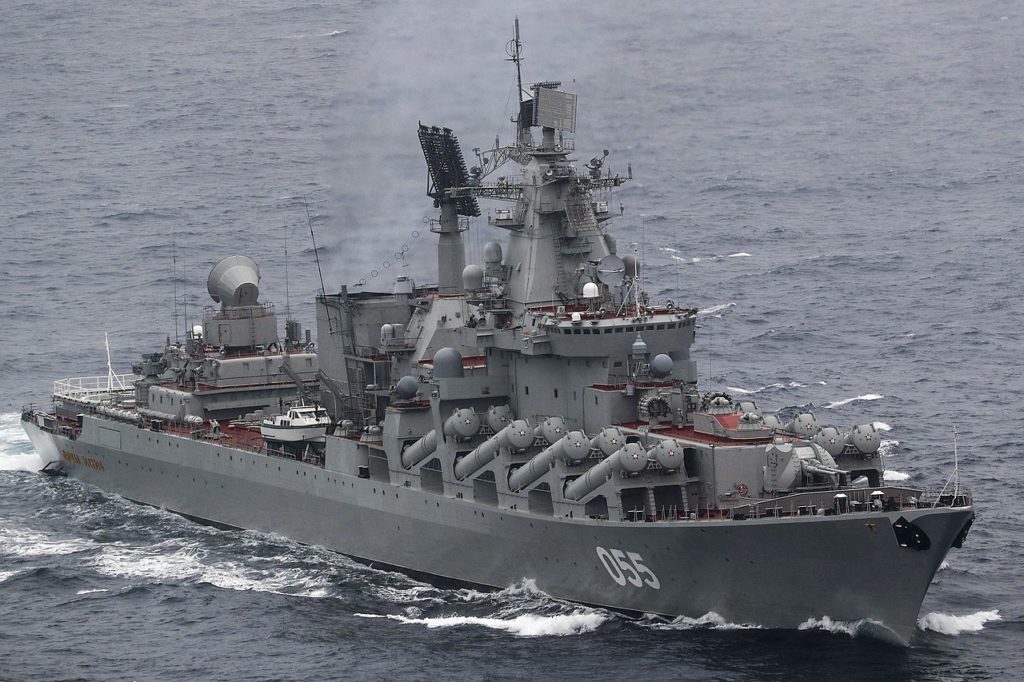
Russian missile cruiser Marshal Ustinov in the 2000s
The Slava-class missile cruisers (Project 1164, for early NATO Black Com-2, then Krasina) were anti-ship units that could replace the four Kynda that reached their age limit. however, from past experience, they were much larger (12,500 tons at full load against 5,600 for the former).
In addition, they all had their cruise missiles not in steerable batteries with refills, but in lateral ramps, fixed and independent. These SS-N-12 bazalt (Sandbox) were supersonic (mach 2.5) and common also to the four Kiev.
They had a nuclear head of 350 Kt or a conventional hollow charge of 1 ton.
They weighted 5, 11.70 meters long and 2.60 meters wide, with a range of 550 km. This system was complemented by two anti-aircraft ramps, medium (SA-N-6) and short-range (SA- N-4).
These were all silos behind the funnnel, 8 silos for SA-N-6 and 2 launchers with 20 missiles each for SA-N-4. The former have, like torpedoes, an alternative tactical nuclear head.
The Slava class were six ships initially planned, but following the political events in the USSR in 1990, only the first four were operational, respectively in 1982, 86, 89 and 93.
The first three were therefore in service in 1990. The other three, Admiral Lobov (started 1984, launched 1990 and planned for completion in 1993) was transferred to Ukraine and renamed Vilna Ukraina, but still lacked equipment to be operational. Ukraine then did not had any means to carry out this work.
As a result, through a joint contract to sell Sovremenny-class destroyers to the Chinese, funds arrived and Ukraina was finally completed in 2001. Rossiya and Admiral Gorshkov were not even started and were soon removed from the lists. All were built in Nikolayev, on modified Kara plans.
The original names of the first three (renamed after 1990) were Slava, Marshal Ustinov and Chervonia Ukraina. Class (renamed): Moskva, Admiral Isakov, Admiral Ustinov, Varyag, Vilna Ukrayina.
They were in service by the 1990s in the Northern Fleet (Ustinov), Black Sea (Ukrayina, Moskva), and Baltic (Lobov). The Moskva (formerly Slava) was sent for modernization to Nikolayev in 1990 and remained there until 2000, as the funds for doing so were insufficient. Of course their status will be refreshed in a future dedicated post.

Author’s illustration of the Slava
Specifications
Displacement: 10,000t, 12,500t FL
Dimensions: 187 x 20.8 x 7.5 m
Propulsion: 2 propellers, 2 DGC turbines, 125,000 hp. and 34 Nodes max.
Crew: 600
Electronics: Radar 2 Top Pair, Top Steer, 3 Palm Front, 1 Top Dome, 2 Pop Group, 1 Kite Screech, 1 Front Piece, 3 Bass Tilt. LF Sonar, 1 SPV, 8 CME Side Globes, 1 Satcom Punch Bowl.
Armament: 16 SSN12, 8 LM SAN6, 2 SAN4 (40), 2 130mm (1×2) guns, 10 TLT 533mm (2×5), 6 Gatling AM 30mm, 2 LR ASW RBU 6000 (144), 1 ASW helicopter Kamov Ka-25 Hormone-B.
Read More
R.Gardiner Conway’s all the world’s fighting ships 1922-1947 & 1947-1995
fr.naval-encyclopedia.com/guerre_froide/flotte_sovietique1990.php#cr
//www.navweaps.com/Weapons/WMRUS_Main.php
Russia to build 2 Lider-class nuclear-powered destroyers by end of 2020s TASS. 28 February 2019
“Russian Future Destroyer “Grown Up” to 19,000 Tons”. 26 February 2019
“Russian Navy Project 23560 Leader-class Nuclear-Powered Destroyers to Slip Behind Schedule”. navyrecognition 2017
“Russia Creating Cutting-Edge Universal Nuclear Battleship”. Sputnik. 23 July 2016.
Berezhnoi S. S. Trofei i reparatsii VMF SSSR. – Sakhapoligraphizdat, Yakutsk, 1994.
Kuzin V. P., Nikol’skii V. I. Voenno-Morskoi Flot SSSR 1945–1991.
Pavlov A. S. Voyennye korabli SSSR i Rossii 1945–1995.
Pavlov A. S. Voyennye korabli Rossii 2001 god. – Yakutsk, 2001.
www.navypedia.org/ships/russia/ru_cr_groznyy.htm
www.navypedia.org/ships/russia/ru_cr_admiral_zozulia.htm
www.navypedia.org/ships/russia/ru_cr_kronshtadt.htm
www.navypedia.org/ships/russia/ru_cr_nikoayev.htm
www.navypedia.org/ships/russia/ru_cr_kirov80.htm
www.navypedia.org/ships/russia/ru_cr_slava.htm
www.navypedia.org/ships/russia/ru_cr_moskva.htm
Armament of Soviet cruisers
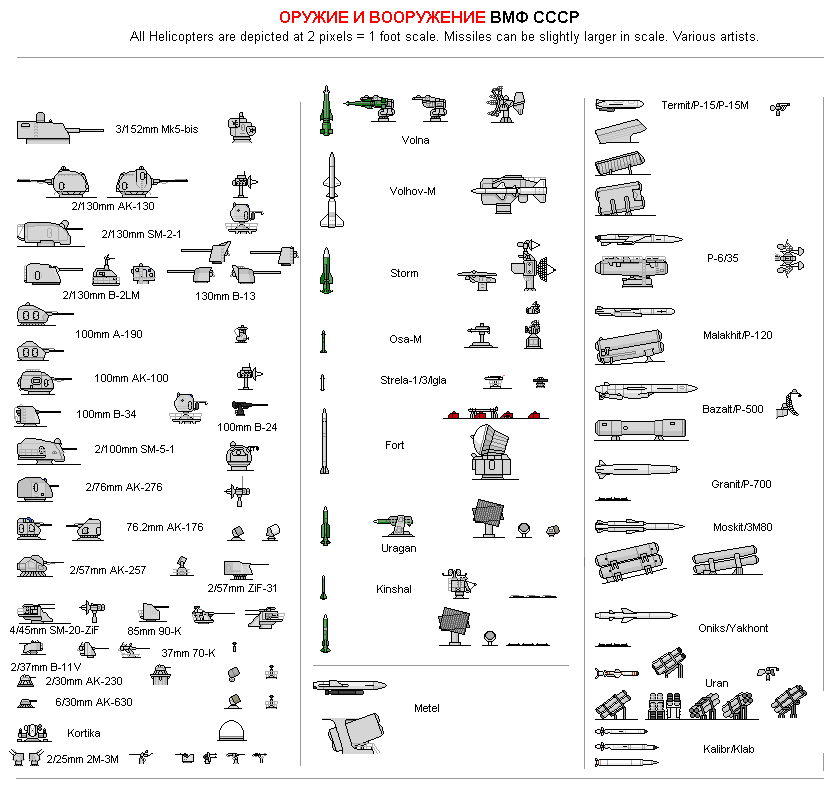
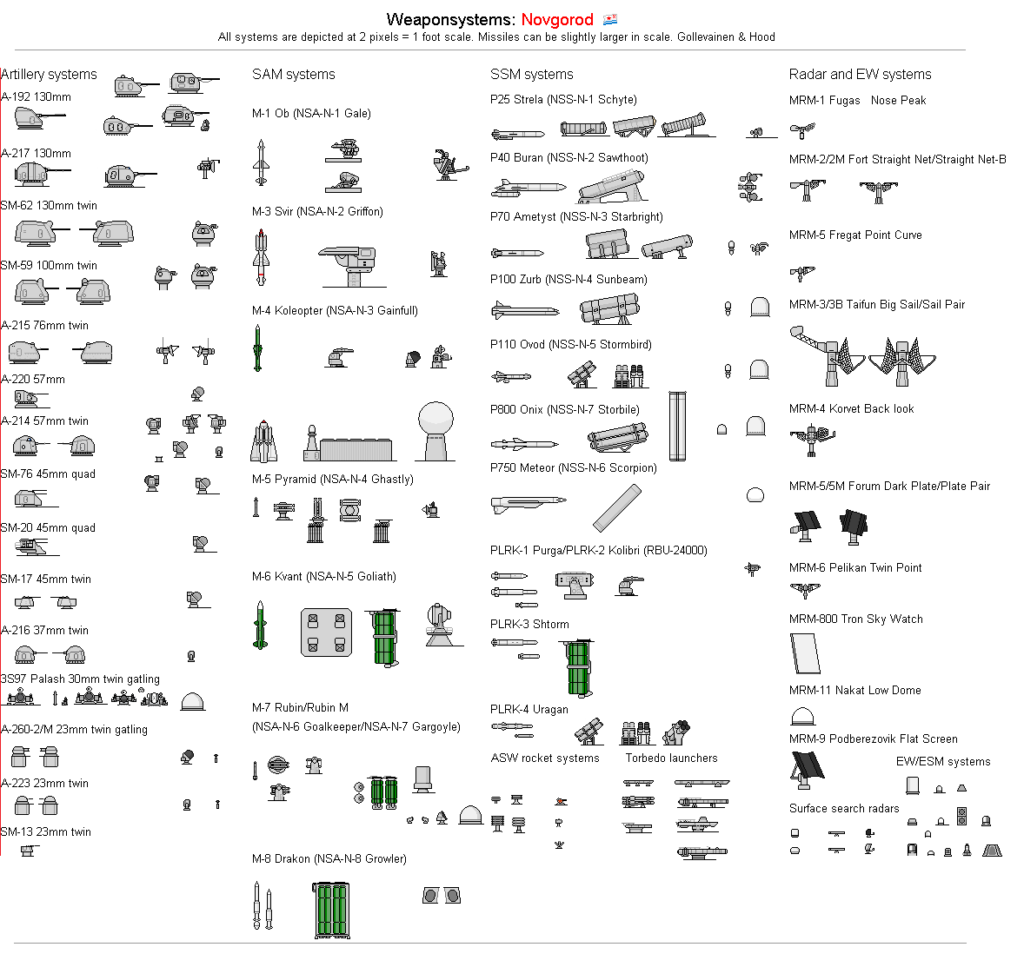
Overview of soviet cold war armments and associated radars and FCS
Cold War Naval Artillery
305 mm/62 (12″) SM-33 Pattern 1948
Stalingrad class, Project 82 class battlecruisers. A prototype gun was built in 1948, tested 1949-1951. 12 were built before cancellation in 1953.
Used the More-82 control system and Grot radar rangefinder with two Zalp FC radars associated to the rangefinder. The breech was of the piston type.

220 mm/65 (8.66″) SM-40:
The largest heavy cruiser guns. Designed for the Project 22 and Project 66 conventional heavy cruisers studied after the war, but Stalin’s death in 1953 provoked the cancellation of both. Work on the turret design was stopped but the team responsible for the gun and its mounting was given the go-ahead for experimental purposes. The prototype was ready in December 1953 and tests at Rzhevsk lasted until November the next year. This gave a report but no production was decided afterwards.
152 mm/57 (6″) B-38 Pattern 1938 Mk5 (1949):
The standard gun for conventional Soviet cruisers, originally designed for the Soviet Battleships started in 1938 and never completed of the Sovietsky Soyuz class. The gun turret was slightly modified and eventually was adopted in 1949 on the cruiser class Chapaev. They originated before the war in 1938 in the “Bolshevik” factory. First gun completed in 1940, ten produced by 1941, used on railroad guns for land service.
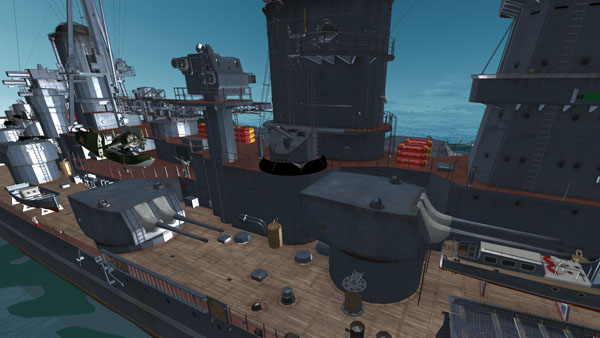
Four different types of turrets were designed. The twin MK-4 was the original DP mount to be used on the Sovetsky Soyuz class. The MK-17 was a lighter twin mount version developed for the Kronshtadt class battlecruisers. The MK-5 was the final triple turret made in 1946-47 for the Chapaev and Sverdlov class cruisers. The MK-9 was a lighter model intended for the modified Sovetsky Soyuz class that was never achieved.
The turret and gun entered service in 1949. It weighted 38,581 lbs. (17,500 kg), a Chamber Volume, 2,002 in3 (32.8 dm3), a rate of fire of 7.5 rounds per minute.
This gun fired an AP shell B-35 weighting 121 lbs. (55 kg), and a semi-AP shell model 1915/28 PB-35 of the same weight, but also a distance grenade and star shell.
The full propellant charge was 52.9 lbs. (24 kg). Muzzle velocity was 950 ms, down to 800 on the Shrapnel/HE mod 1915/28 (OF-35). Overall this was not a bad design, it was still average compared to the same caliber guns on the Cleveland class, but certainly not on the level of the Worcester class’s semi-automated twin 6-in/47 Mk16 DP, in particular on the late Sverdlov types in service until the 1980s. More >
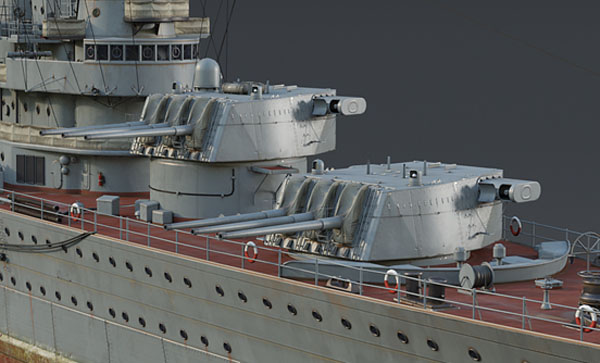
130 mm/70 (5.1″) AK-130
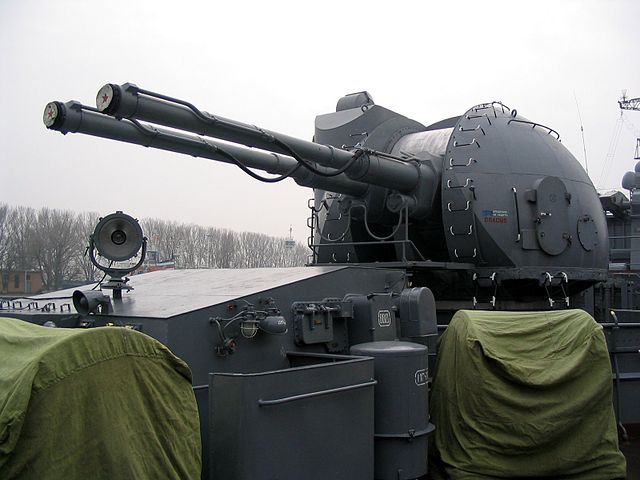
The most powerful dual purpose automatic twin gun anywhere on the world. Design work started by PO Arsenal by 1967. The A-217 was a single mount, and the barrel was liquid cooled. 60 RPM was the target, never reached in trials, so a twin mounting was preferred to compensate. The design was completed in 1980 and factory designation was ZIF-94. It entered service in 1985. It was controlled by the MP-184 Fire Control Radar System: 2-band radar, low light TV, laser designator, moving targets selector, ESM.
Range was 75 km and the gun tri-axial stabilisation system was fed with exact measurement of all parameters of movement for air, sea and land targets. This included water plums correction and automatic shell tracking. Used on the Sovremenny, Slava and Kirov Classes. More >
100 mm/70 (3.9″) AK-100
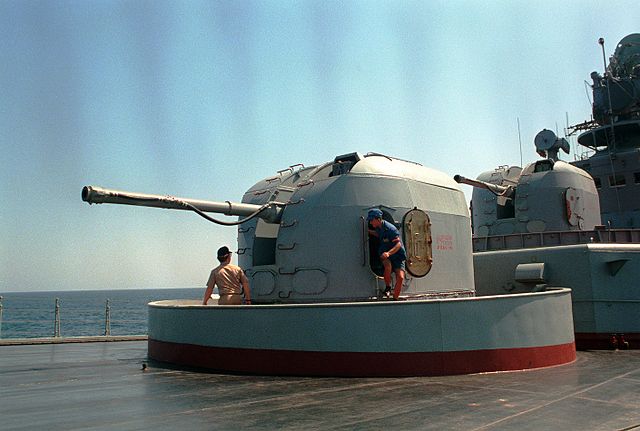
Used on the Kirov class and Udaloy, Bditelny and Neusrashimy Classes destroyers.
“Arsenal” factory design, original designation ZIF-91. Trials started in 1973, but design started in 1967. It was introduced in service in 1978, designated AK-100 while the gun itself was A-214. This was a recoil-operated automatic cannon with a water-cooled barrel, of course dual-purpose. Used an optronic analog control system, “Lev-114”. The gun sight was “Kondensor-214A”. More >
100 mm/70 (3.9″) CM-5:
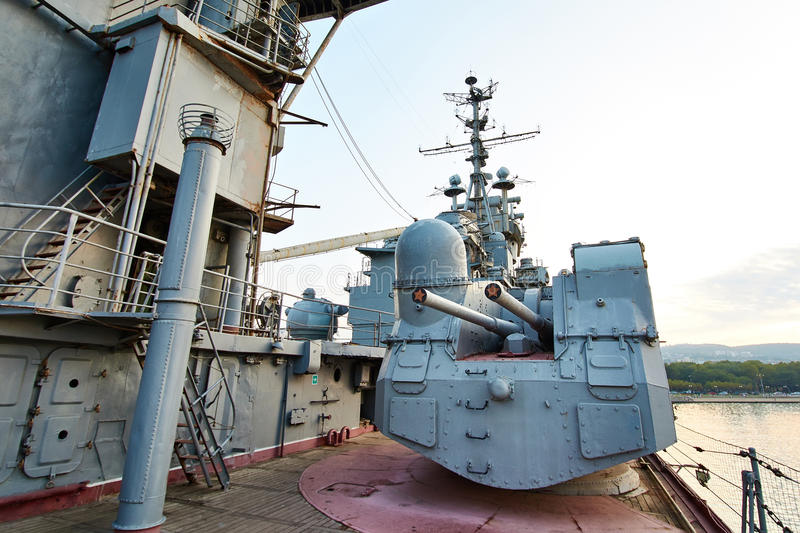
CM-5 on the cruiser mikhail Kutuzov (Dreamstime)
This was the standard dual-purpose secondary armament of the Chapaev class, Project 68 cruisers. Production spanned from 1948 to 1955, 150 made in all, for the five Chapaev class and the twenty Sverdlov class Project 68bis conventional cruisers. A quadruple mounting was even designed in 1949 but never approved.
They were managed by a Zenit-68bis A Fire Control System. The latter also controller lighter 37 mm guns. Aiming was assisted by the Yakor radar and SPN-500 associated system. Final targeting data was transmitted by the TsAS-1/PKU-1 systems which allowed the guns to be aimed even if the central computer was inoperative/disabled.
The mounting was stabilized up to -20/+20 roll degrees by using a Jenny-type coupling using the D-5S remote control system. A loose liner, casing and barrel nut on support ring were used for the barrel and for the mount a sliding breech block springing automatically but no individual sleeve. Rate of fire was 18 rpm and muzzle velocity ranged from 2559 to 3281 fps depending of the ammo type, Frage, AA, star shell and ECM shell. More >
76.2 mm/59 (3″) AK-726
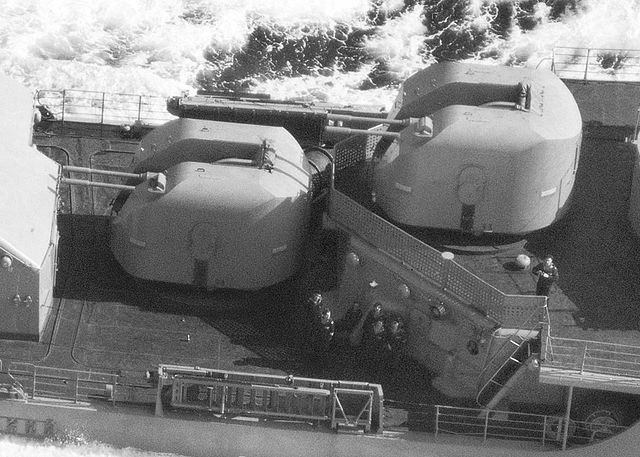
Standard AA gun used on the classes Kiev, Kara, Kynda and Kashin. Development started in 1954 and went to 1959, approved as ZIF-67. After extensive trials in 1958-59 and shipboard trials in 1960-62 it was approved for production in 1963 and 104 mounts were manufactured until 1964. It was managed by a Fut-B control system. It was efficient for an air target up sto 1,780 fps at a maximum altitude of 19,700 feet (6,000 m) and 11 miles (18.3 km) range. Against ship targets it was efficient up to 5 miles (8.2 km).
Monobloc barrel, with spring receiver, common cradle, and recoil-based automatic mechanism. Not water-cooled but sea water pumped between salvoes when the gun was at rest in a 2-3 minutes process. The mount design allowed them to be aimed at high elevations. Fired at 55 rpm and 3,215 fps (980 mps) muzzle velocity either an AA shell ZS-63 (27.34 lbs, 12.4 kg) or FRAG shell OF-62 (27.34 lbs, 12.4 kg) coupled with a propellant charge of 6.72 lb. (3.05 kg). Barrel life was around 3000 rounds in average. More >
57 mm/75 (2.24″) AK-725 (ZIF-72)
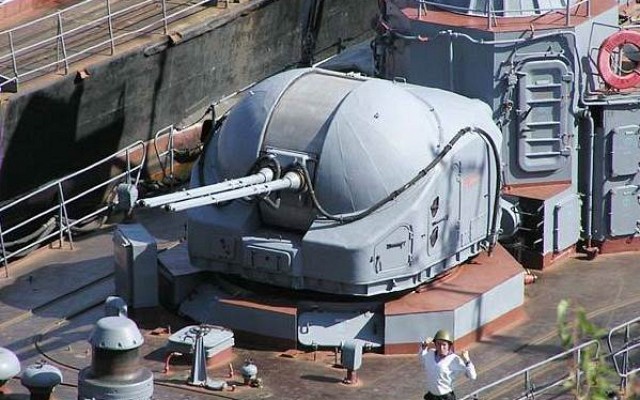
Standard light AA, used on the Moskva class helicopter cruisers, Kresta I and Kresta II missile cruisers. It was developed from the unsatifactory 57 mm ZIF-31/ZIF-71 mounts of ww2. In 1956 a request for a new weapon system with such caliber was issues and in 1959 a prototype was ready, trialled from 1960. The barrel was found too fragile, with a very short live, but improvements in that sense gave it a tolerance up to 750 rounds. The mount was accepted in 1964, as AK-725.
This was a twin mount, water-cooled, using belt ammunition, able to fire longer before reloading. It could fire longer bursts with 80% less cooling time. 550 rounds were in each belt. Reload was manual. Managed by the ESP-72 fire control system/MP-103 Bars radar with a simple optical gunsight bakcup in case of the main FCS was disabled. Production stopped 1988. It was pretty standard and just powerful enough to catch most planes strafing.
It was trialled but failed against anti-ship missiles. The barrel was monobloc with vertical blade type breech and standard barrel recoil on a common cradle. No armor protected the servants but 6 mm (0.24 in) thick aluminum plates. 200 rpm, 3280-3346 mps muzzle velocity, fired the Tracer-FRAG (UOP-281/U), and HE shells (UFB-71). More >
ZIF-31 57 mm AA
A surface-ship version of the SM-24 land mount, converted in 1954, trialled and accepted for service in 1955. ZIF-31 and ZIF-31S had a central fire control system and the ZIF-31B/BS local control. These were open mounts, problematic for the Arctic Ocean and no NBC protection possible. They were slow to reload, clip fed, and needed to be cooled after a 50 rounds bursts by urunning sea water for 1.5 minutes. Was replaced by the ZIF-72 (AK-725). Possibly used on the Sverdlov/Chapaev class cruisers.
45 mm/78 (1.77″) SM-7
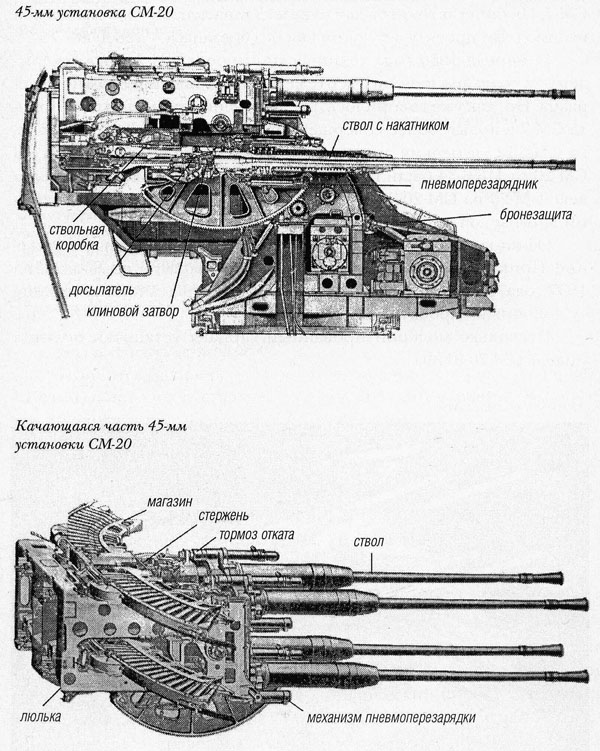
Standard light AA, usually quad mount. It was designed in 1946 and tested 1946-50. The SM-21 single mount appeared in 1947-48, tested in 1949. Requirements were rewritten and a modified prototype was created in 1950, tested next year. It was refined and accepted for service in 1954. Used both the SM-16 stabilized and SM-17 unstabilized twin mount but production was denied.
Instead the SM-20 quad mount was mated with the SM-7 gun and the whole system reworked and accepted into service in 1957.
The top barrels recoiled when the bottom barrels were firing, causing some dispersion. Single cradle, cooled between firings (sea water from a fire hose nozzle). Central control system or local control. Used with the BL-11 mount on Project 68 light cruisers. The ZIF-69 mount was to be adopted but the project was cancelled and they were recycled on destroyers. Barrel was of monobloc construction, automated recoil-based system, piston type breech, belt/clip loading. The M-20/ZIF-68 fired at 540 – 640 rpm combined (four barrels). Muzzle velocity was 3,540 fps (1080 mps) with a HE (F-75) shell (3.11 lbs -1.41 kg) or FRAG OR-75 shell (3.11 lbs. -1.41 kg). More >
30 mm/63 (1.2″) AK-230
The US Navy Phalanx system is well-known, using the old Patented Gatling system, and the preferred method against missiles at short range. But the Soviet Navy had its own system quite soon.
The AK-230 was Widely used on Soviet ships 1960-1980s and was widely exported, also made in China as Type 69. Design started in 1956 as a super-fast, short range AA gun in 1957, with lots of redesigns and tests in 1958-1960, and trials in 1960-68 with further modifications. It was accepted as AK-230 in 1969 hereas production had already started in 1959. It was an automatic fully stabilized mount with twin 30 mm (1.2″) liquid-cooled revolver cannons. The exhaust powered the recoil and they were belt fed, each with 500 rounds.
Version A mount was had a 220 Vdc power system supply and B 380 Vac 50 Hz power system. A low magnetic version was made also for minesweepers. Capable of 1000 rpm it could only fire a 30 second burst before extinguishing the belt. This was largely enough to “kill” any target down to its range. The AK-230 could fire HE-FRAG OF-83 rounds (0.78 lbs-0.354 kg), HE F-33 rounds (0.794 lbs -0.36 kg) and an AP Br-83 round (0.794 lbs -0.36 kg). Muzzle velocity ranged from 3,440 to 3,478 fps. Range varied from 4,374 yards (4,000 m) to 7,327 yards (6,700 m). More >
30 mm/54 (1.2″) AO-18 Gun (AK-630)
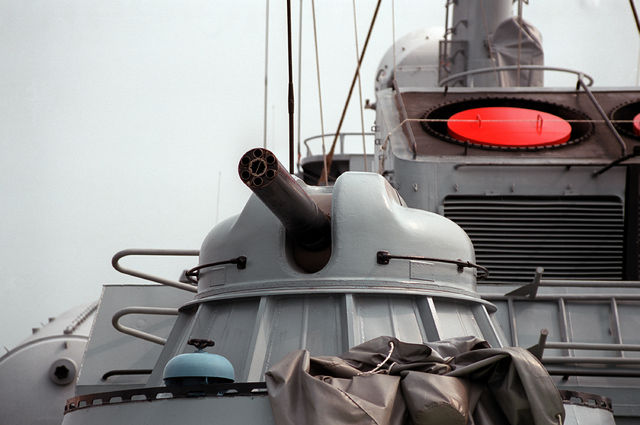
This was the true “Gatling” soviet-built antimissile system. The previous AK-230 was found able to destroy incoming missiles with the HE Frag burst, and a dedicated gun was designed from 1963. The development process lasted until 1964, with trials in 1965-1966 and with further modifications, up to 1976 before it was accepted for service. Production had started in 1969 in Tula already and the modified AK-630M/A-213M was accepted into service in 1979.
This is a 6-barreled Gatling style gun AO-18, all made in single block, with an exhaust-driven jointed automatic system. Of course this is a belt-fed, flat-magazine system (AK-630) or drum magazine (AK-630M). They are part of the A-213-Vympel-A system including a radar and optical and TV control systems. This system could also control a 57 mm gun at the same time. It was efficient up to 4,000 m (4,400 yards) and 5,000 m (5,500 yards) for ships. The TV control system spot any targets up to 75 km and fighters at 7,000 m (7,600 yards). It is fully automatic and independent to get rid of human slow response and reaction time. There is however an optical control backup, notably usable against land targets.
The AK-630/M was able to 4,000 – 5,000 rounds per minute and the AK-630M1-2 10,000 rounds per minute, like the modernized 3M87. This system can fire the HE-FRAG OF-84 (0.86 lbs-0.39 kg) or the
FRAG tracer OP-84 (0.86 lbs-0.39 kg) at a muzzle velocity of 2,953 fps (900 mps). The Palash system fired faster rounds at 3,609 fps (1,100 mps) but it is down to 1000 rpm. More >
The AK-306 was used on light crafts, notably air cushion and ekranoplanes plus small motor boats. It used the exhaust and electricity and lacked radar control (optical only) to be used rather like a surface-to-surface weapon. development started in 1976, and it was accepted into service in 1980. Three years later, the AK-630 evolved into the AK-630M1-2 “Roy”. It had the new AO-18 six barrel blocks one above the other, tested 1984-1989, but never produced as antimissiles missiles were ready by that time.
The 3M87 “Kortik” system used two AO-18 six-barrel blocks plus eight 9M311 missile launchers with ammunitions in drums. Missiles could engage targets at 1,500-8,000 m (1,600 to 8,750 yards) until the guns took over. Trials started in 1983 and production started in 1989 until 1994. As the 3M87 was larger and taller than previous system it could niot replace it and was used on new ships only.
The twin AO-18KD “Palash” six-barrel blocks/eight missiles was developed in the 1990s for export and could be coupled with the Strela-10, Igla, Stinger or Mistral or Sosna R missiles.
Soviet Cruisers Missiles
Soviet Ship to Ship missiles
P-5 Piatiorka (NATO SS-N-3C)

Used on the Kynda & Kresta class class. The P-5 Piatiorka (П-5 “Пятёрка”) NATO SS-N-3C Shaddock, was a cruise missile with a Soviet inertial guidance system designed by the Chelomei design office. The P-5 entered service in 1959 and its basic version carried either on ton of TNT warhead or a nuclear one 200-350 kT. The missile flew at 0.9 Mach over 500 km and could climb to 3000 m. The last variant had an 1000 km range. The SS-N-3C was retired from service in the early 1990s.
It measured 10,20/11,75 X 0,98 m with a wingspan of 5 m, weighted 5 000 kg.
P-35 Termit (NATO SS-N-3 Shaddock)
Initially planned to be used on the Kynda class cruisers but given to Komar FACs instead.
This missile was 9.8 m x 86 cm, wingspan 2.67 m, and Weighted 4200-4500 kg. It carried a 560 kg warhead/405 kg TNT. It could reach up to 7 km alt, 300 km range, mach 1.3.
RPK-3 Metel (SS-N-14 ‘Silex’)
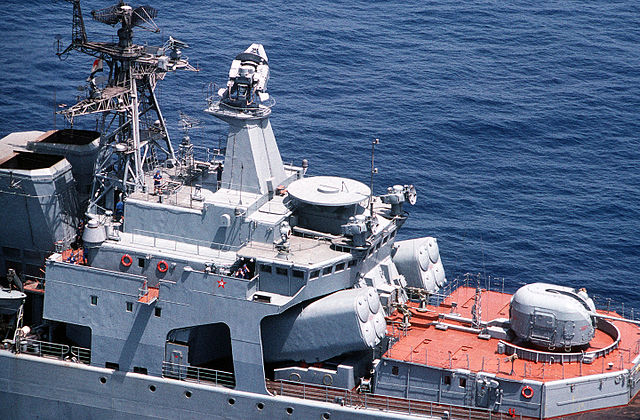
SSN-14 launchers onboard an Udaloy ship
Dual SSN/ASW missile, Kresta II, Kara, Udaloy and Kirov class. Basically since the USN introduction of the ASROC, the Soviet Navy needed a response. This came in 1969 with the RPK-3 Metel weapon system introduced in service. It used the same basic principle: A missile carried a torpedo on the supposed location of the submarine, and the self-guided torpedo would do the rest. To ease development, it was based on the P-120 Malakhit (NATO: SS-N-9 ‘Siren’). The missile was radio command guided, powered by a solid fuel rocket motor.
It carried a UGMT-1 multi-purpose torpedo, or a nuclear depht charge and was aimed at the target via IR sensors. In ASW mode the missile flew at approximately 400 m high before releasing the vector, but was sea-skimming at 15m over the waves in antiship mode. In that case, the SSN-14 carried a 185 kg shaped charge warhead.
The missile measured 7.2 m (24 ft) and weighted 3,930 kg (8,660 lb).
In 1993 an upgraded version designated YP-85 appeared with a range of 250 km (130 nmi), aimed at export.
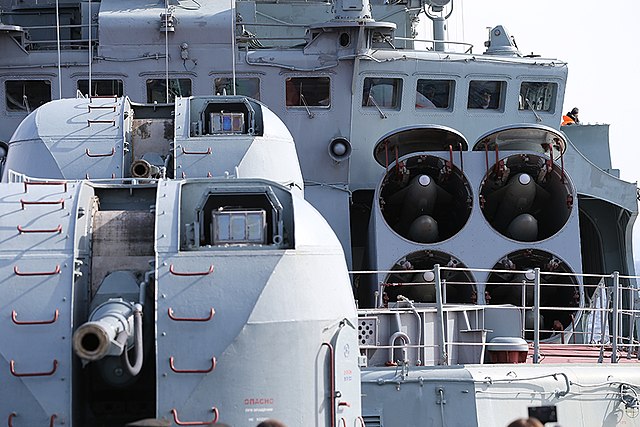
-Weight: 3,930 kg (8,660 lb), 7.2 m long
-Warhead: ASW torpedoes/nuclear depth charge/185 kg shaped charge warhead.
-Propellant: Solid fuel rocket
-Range 90 km for 85RU/URPK-5 Rastrub/50 km ASW
-20–500 m depht, Speed Mach 0.95
-Guidance: Radio command via helicopter, IR seeker.
Soviet Ship to Air missiles (SAM)
SA-N-1 ‘Goa’
This was a naval version of the M-1 Volna (SA-N-1) which development started in 1956. Tested on a rebuilt Kotlin class destroyer (Project 56K) named Bravyi in 1962. Called V-600 and 4K90 its range was rather short, 4-15 km and up to 10 km ceiling. Fire control and guidance was made by the 4R90 Yatagan radar. Volna could be also used in an emergency mode against closing in naval targets.
It was a two-missile launcher called, ZIF-101, with 16 missiles in magazine, replaced by ZIF-102 (32 missiles) and Volna-M (SA-N-1B) furing the improved V-601 (4K91) missiles capable of 22 km range or 14 km ceiling. The Volna-P had an additional TV target tracking channel and resisted better to jamming. The last upgrade was the V-601M missile which can skim over the waves. Used by the Soviet and Indian navies.
-Weight: 953 kg, 6.09 x 0.375 m, Wingspan 2.2 m
-Warhead: Frag-HE 60 kg Proximity fuse
-Propellant: Solid propellant rocket motor 35 km (22 mi) range
-Flight altitude: 18,000 m (59,000 ft
-Guidance system: RF CLOS
SA-N-3 ‘Goblet’
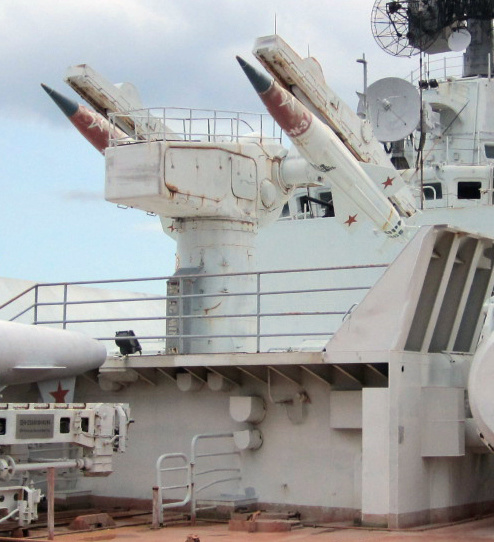
Called in Soviet service the M-11 Shtorm (“storm”), this naval surface-to-air missile system (SA) GRAU designation was 4K60 and NATO reporting name SA-N-3 Goblet. Work started at the Scientific Research Institute 10 (NII-10) in 1959, completed in April 1962, but first use was diapointing because of the mounting which needed much modifications until 1964 when it was ready, but it was still not accepted into service. Just in time to be first installed on Moskva, the new anti-submarine cruiser commissioned in 1967. The system was officially accepted into service in 1969. Having no land-based counterpart it has never been fired in anger. It was installed later on the Kara, Kresta II, and Kiev classes.
NATO designated the initial 4K60 M-11 “Shtorm” V611 missiles SA-N-3A and the upgraded 4K65 “Shtorm-M” /V611M missile SA-N-3B.
Specifications:
-4K60/41K65 mounted on a rotating twin rail launcher
-Dimensions 6.1 m (20 ft) long
-Speed: Mach 2-3.
-Weight 845 kg (1863 lb), 80 kg (176 lb) warhead.
-Altitude 100–25000 m (328-82,000 ft)
-Range of 3–30 km (2–19 miles)
-Upgraded 41K65 range: 55 km (34 mi).
-Guidance radio command, terminal semi-active radar homing (SARH).
-Associated radars “Head Light” +”Top Sail” search radar.
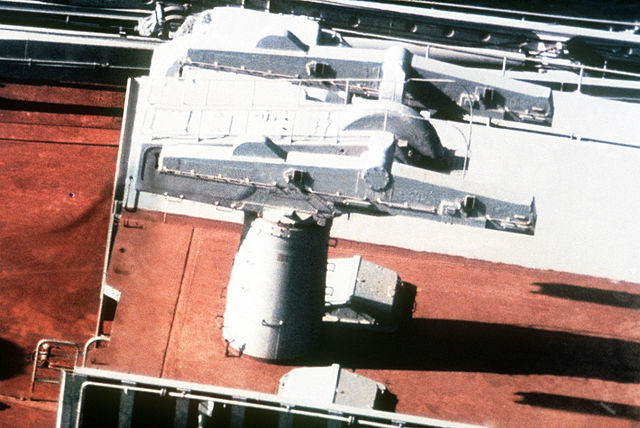
SA-N-3 onboard Kiev
SA-N-4 ‘Gecko’
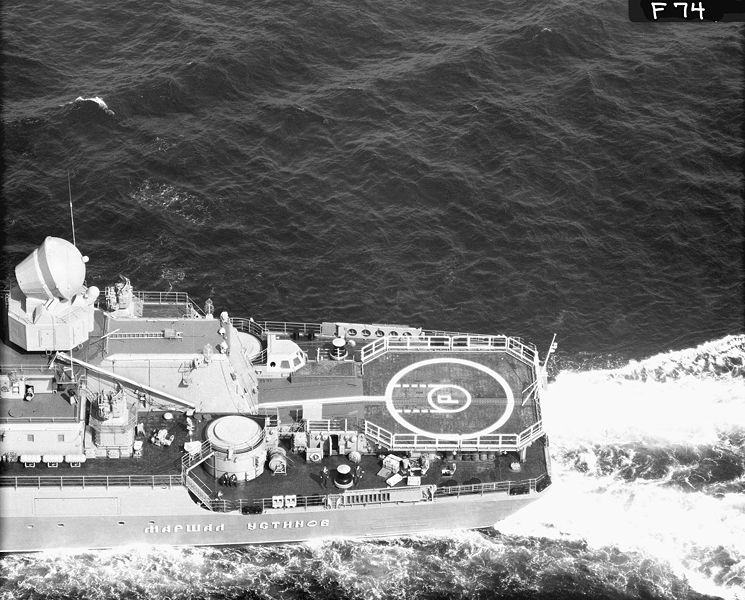
Derived from the OSA-M SA system (navalized as SA-N-4 – NATO “Gecko”), the ubiquitous, globally successful 9K33 Osa gave a potent short range SAM for the Soviet Navy. The system was deployed onbard the Slava class, inside wells in the middle of the hull. Development started in 1963 but production in 1972. The naval version was introduced in 1974.
Specifications:
-170 kg, 3158 mm long, diameter 209.6 mm.
-Carrying a warhead of the 16 kg Frag-HE type, with a Contact or proximity fuse.
-Propelled by a solid propellant, dual-thrust rocket motor
-Range 15 kilometres (9.3 mi), alt. 12,000 metres (39,000 ft)
-Boost time 2 s, 15 s sustained at 1020 m/s
-Guided by RF CLOS, 5 m accurate
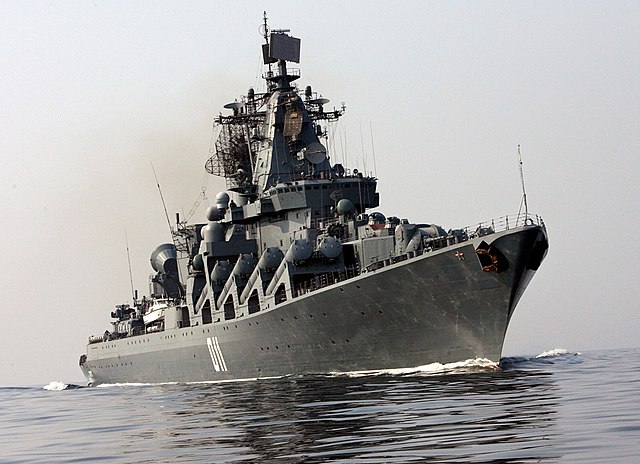
Missile cruiser Varyag underway during the Pacific fleet celebration day, on May 21, 2001
SA-N-6 ‘Grumble’
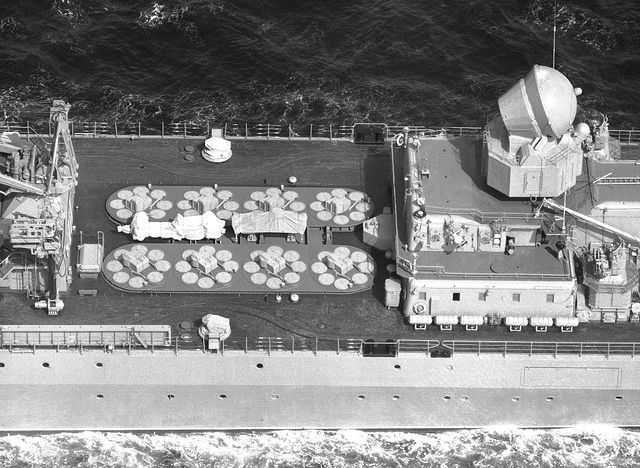
Standard long range SAM of the Soviet Navy in the 1980s, derived from the land-based S-300 missile system. It was developed originally to destroy not only planes but also cruise missiles and even later some variants targeted ballistic missiles as well.
The S-300F Fort (F stands for “fleet”), NATO SA-N-6 “Grumble” was introduced in 1984. It was derived from the S-300P developed by Altai, featuring the new 5V55RM missile. The maximum range was 90 km, reached at Mach 4 and an altitude of 25–25,000 m. Its guiding system rests on the TOP SAIL/TOP STEER, TOP PAIR and 3R41 Volna TOP DOME radars. Its own onboard system is a terminal semi-active radar homing (SARH). The Kara class cruisers were the first to carry it, followed by the Slava class, and eventually the first three Kirov class battlecruisers. storage varied, from 8 to 12 on the Kirov, with 8-barillet rotary launchers below decks.
SA-N-20 ‘Grumble’
The S-300FM Fort-M, also designed SA-N-20 was in fact the second naval version, installed only on the Kirov-class cruiser Pyotr Velikiy. The missile itself was called 48N6. It was introduced in 1990. Speed was now Mach 6, up to Mach 8.5 for the final reach. Its warheaded was increased to 150 kg (330 lb) and range up to 150 km and 27 km altitude. It has a more modern guidance method, and was able to intercept short-range ballistic missiles.
It used the TOMB STONE MOD radar. It was modernized to introduce a secondary infrared terminal seeker to avoid saturation ECM and engage targets beyond the horizon, including sea-skimming anti-ship missiles.
China developed its own version from 2002 (Type 051C guided missile destroyers).
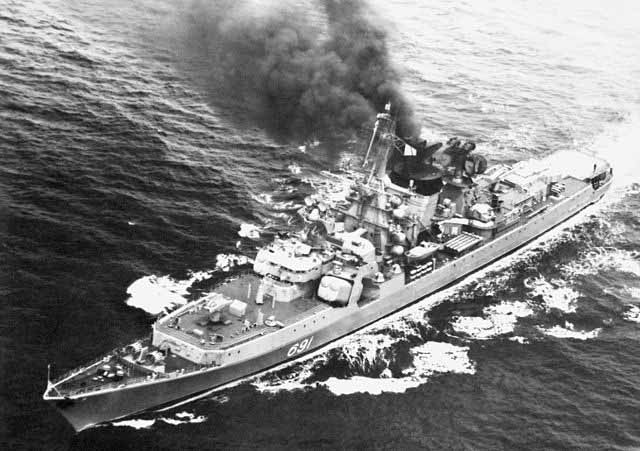
Marshal Timoshenko in 1986
Soviet cruise missiles
P-270 Moskit (SS-N-22 Sunburn)
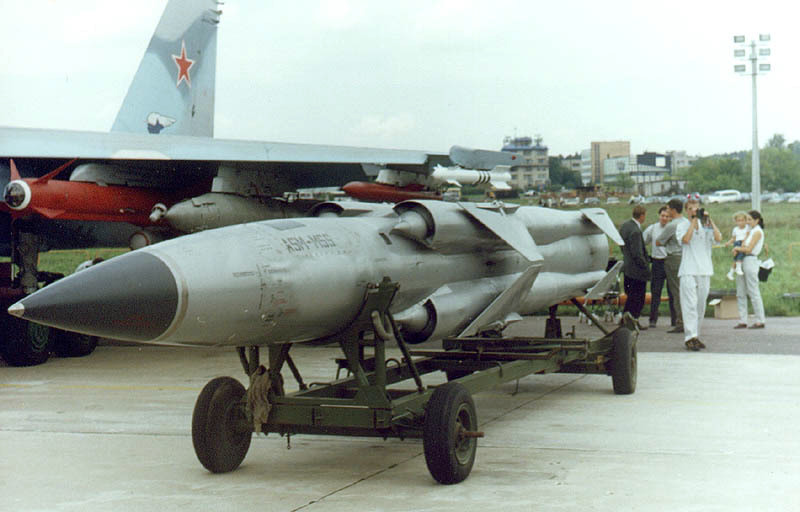
This was the Soviet supersonic ramjet anti-ship cruise missile. Design was ready in 1978, accepted 1981 and deployed from 1983. GRAU designation 3M80, NATO SS-N-22 Sunburn. A product of the Raduga Design Bureau during the 1970s to succeed to the P-120 Malakhit (SS-N-9 Siren) deployed on the Echo and Charlie class missile attack submarines.
The Moskit was later adapted to mobile truck launchers and underwater launchers as well as an air version carried by the naval Sukhoi Su-33. A rarer craft, the Lun-class ekranoplan also carried it. It could deliver both conventional and nuclear payloads. It has been exported and licence-built by China and India since.
Specifications:
-Mass: 4,500 kg (9,900 lb), 9.745 m x 0.8 m x 2.10 m (wingspan)
-Warhead: 150 kg (330 lb) explosive/120 kt thermonuclear
-Propulsion: Four ramjets, speed Mach 3
-Range 250 km, at flight altitude 20 m
-Guidance: inertial + terminal active radar homing
P-500 Bazalt (SS-N-12 Sandbox)
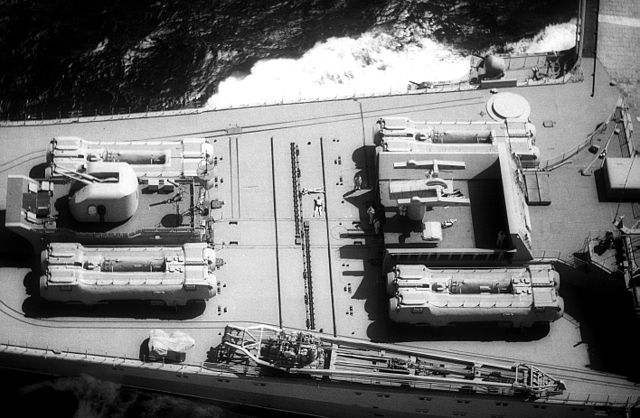
This turbojet supersonic cruise missile was designed by OKB-52/NPO Mashinostroyeniya Chelomey from 1962 to 1974 and introduced in 1975.
GRAU designation is 4K80, NATO SS-N-12 “Sandbox”. It was a upgraded naval version of the P-1000 Vulkan. It has been deployed on the large Kiev and Slava class cruisers, as “aircraft carrier killers”. They were first issues on the Echo II and Juliett class attack submarines.


Comparison between the turbojet P-500 Bazalt (top) and P-1000 Vulkan (bottom).
Specifications
-Mass 4,800 kg, 11.7 m x 0.88 x 2.6 m (ws)
-Warhead: HE 1-ton/950 kg semi-AP or Nuclear 350 kt
-Propulsion: Turbojet, Mach 2.5
-Range: 550 km (300 nmi) at 50–5,000 meters
-Guidance: Semi-active radar homing, terminal active radar homing
P-700 Granit (SS-N-19 Shipwreck)
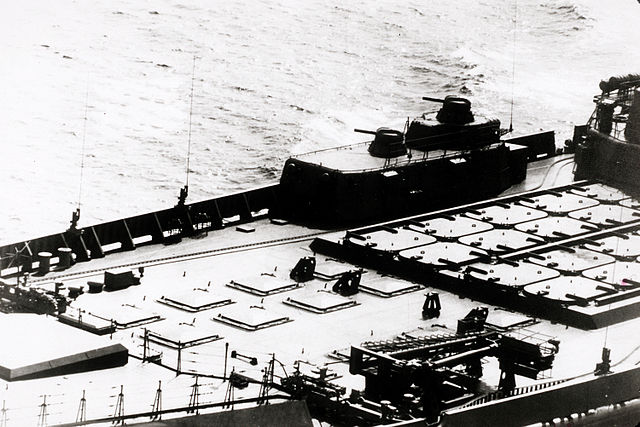
SSN-19 launchers on the Kirov-class cruiser Frunze.
The P-700 Granit designed in the 1970s by OKB-52/NPO Mashinostroyeniya, Vladimir Chelomey was the next-generation Soviet naval anti-ship cruise missile. GRAU designation 3M45 NATO SS-N-19 “Shipwreck” was also declined into a submarine-launched variant and was able to take out ground targets as well. Introduced and accepyted in 1983, production started in 1985 and was terminated in 1992. It is still highly valued in Russia. It is given a stubby cylindrical solid-fuel rocket fitted for the launch and detached after the missile reached its cruise altitude and speed. NATO long thought it has a turbojet, but it was established later having a ramjet for unimpressive speeds of Mach 2.5. Its cruiser speed is Mach 1.6.
The SS-N-19 was introduced on the Oscar-class submarines and on the Kirov-class battlecruiser and the sole Kuznetsov-class aircraft carrier. However since the 2020s they are scheduled for replacement by the smaller Oniks and Kalibr cruise missiles, giving them twice the numbers for saturation fire. It is widely believed that the Soviet-era Legenda satellite targeting system never properly worked.
Specifications
Mass: 7,000 kg, dimensions 10 m x 0.85 m
Warhead: HE 750 kg, Nuclear 500 kt
Engine: Turbojet/ramjet
Range: 625 km at Mach 1.6 – 2.5+
Guidance: Inertial + active radar homing with home-on-jam
Torpedoes
As this subject will be treated more in detail with Soviet missile destroyers, here are the main types used by Soviet conventional and missile cruisers (RKR) of the Soviet Navy:
-Standard x5 533 mm (21 in) on Chapayev, Sverdlov, Kynda, Kresta I, Kresta-II, Moskva, Kiev, Slava class (Undisclosed type)
-533 mm PTA-53-1134B x5 torpedo tubes on Kara class.
-533 mm ASW/ASuW torpedo tubes, Type 53 torpedo/SS-N-15 ASW missile (Kirov class)
ASW rockets
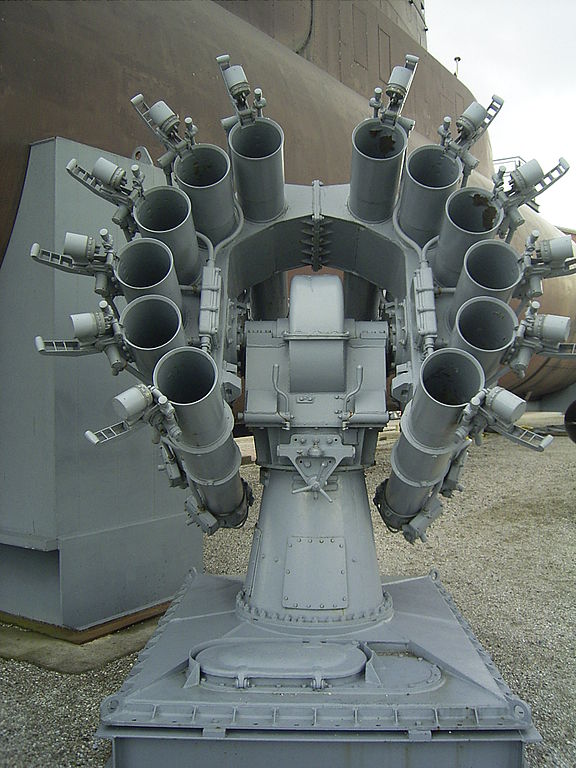
RBU-6000 launchers:
Standard since the Kynda class RKR, Kara, Slava, Kirov, Moskva, and Kiev classes.
The RBU-6000 (Smerch 2, RBU stands for Reaktivno-Bombovaja Ustanovka) became the standard soviet ASWRL (anti-submarine rocket launcher) of the cold war. It was a 1961 designed 213 mm caliber, 12-tubes system designed to launch the RGB-60 depth charges, remotely-guided by the Burya fire control system. It was fired in salvoes, from a single tube up to the twelve tubes at once. Reload was made by a barillet storage below deck magazine, 72 or 96 rounds. Due to the quick reload and multiple uses of the charge, it could be used against ground targets as well.
The RBU-1000 is a shorter range version, only deployed on the Kara class ASW cruisers. The RBU-6000 was modernized with the RPK-8 system of charge guidance down to 1,000 m underwater. The 90R rocket entered service in 1991.
Launcher Specifications:
Mass 3,100 kg, dims. 2 x 2.25 m x 1.75 m
Elevation -15° to +65°, Traverse: 180°
RGB-60 specifications:
Weight: 113.5 kg, diam. 0.212 x 1.83 m long
Warhead: 23 kg DC
Range: 350 – 1700 m and 5500 m in ballistic mode
Operating depth down to 500 m at 11.6m/s
Powerplants and electronics of cold war Soviet cruisers
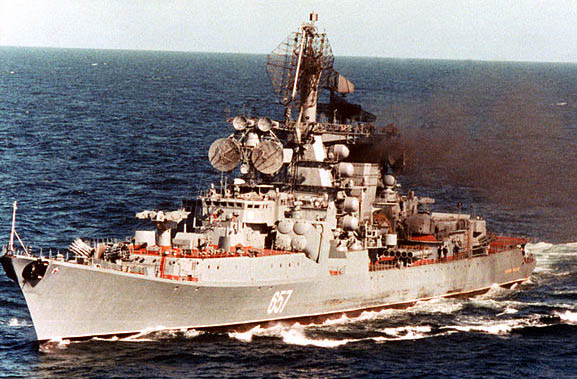
Admiral Yumashev
Propulsion
Classic propulsions:
-TheKynda class was propelled by classic Soviet cruiser propulsion: Two steam turbines, 2 boilers, 100,000 shp, top speed of 34 knots (63 km/h; 39 mph) but range limited to 7000 nmi at 14 knots.
-The four Kresta I Group had the same arrangement and about the same power, 68,000–75,000 kW (91,000–100,000 shp) but much greater range (12,100 mi) at the same speed.
-The ten Kresta II had the same powerplant but with four booilers, same power, same top speed, but less range at 10,500 nmi.
-The innovation came from the seven ASW cruisers of the Kara class:
For the first time on Soviet cruisers, they inaugurated a powerplant using two COGAG units (Combined gas or gas), four DN59 combined to two DS71 gas turbines, which produced altogether 120,000 hp (89,000 kW) and procured the same speed at 34 knots (63 km/h; 39 mph), however with less range, at 9,000 miles for the same cruise speed as above.
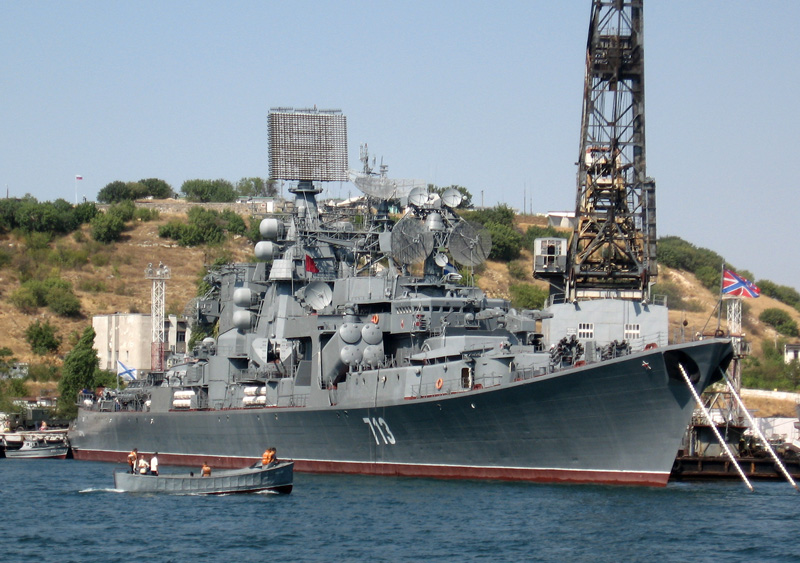
Kerch, a Kara class, at Sevastopol in 2007
-The large Moskva class were given the classic cruiser turbines, on two shaft, fed by 4 pressure fire boilers, procuring the standard 75,000 kW (100,000 hp), but due to their much larger displacement, a top speed down to 31 knots (57 km/h). This was still largely enough to track down submarines of the time. Their range however was largely superior, at 14,000 nautical miles (25,928 km) at 12 knots (22 km/h), fitting their ASW patrol role.
-The Kiev class were given conventional powerplants, but with a twist: These were eight turbopressurized boilers mated to 4 steam turbines which procured twice the power of classic cruisers, at 200,000 shp (150,000 kW)), passed on four shafts. This was enough to reach a top speed, sustained of 32 knots (59 km/h; 37 mph). Range is unknown, probably in the order of 15,000 nm.
–Kuznetsov class large aircraft carrier cruisers: With their displacement way above, ranging from 43,000 tonnes light, 55,000 tonnes standard and 58,600 tonnes fully loaded, the three Kuznetsov class were given classic steam turbines of 80,000 shp (60,000 kW), producing a total of 200,000 shp (150,000 kW). Top speed fell to 29 kn (54 km/h; 33 mph) and range to 8,500 nmi (15,700 km; 9,800 mi) @ 18 kn (33 km/h; 21 mph), hardly optimal for a global-spanning naval force.
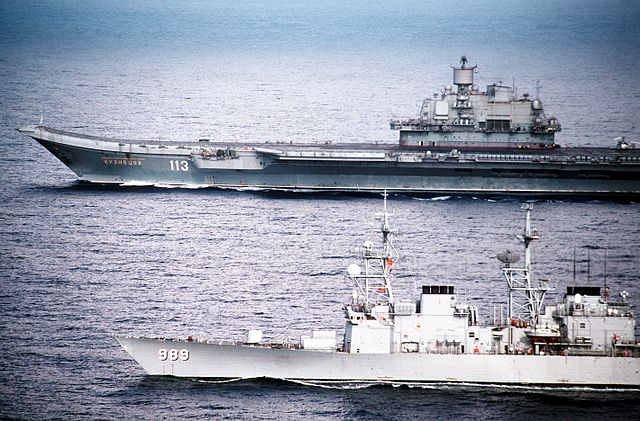
USS deyo and Admiral Kuznetsov
Nuclear propulsions:
It was applied only on one class due to its cost and complexity:
-The Kirov class “battlecruisers”: Nothing was to be spared to these jewels of Soviet engineering, massive ships displacing 24,300 tons standard and 28,000 tons fully loaded. They were actually nimbler compared to the Kiev class (42,000–45,000 tonnes fully loaded). So why choosing nuclear plants ? One was because this was the choice made by the USN for the USS Long Beach, or just to test this arrangement for future developments (notably the heavy aicraft carrier cruisers). This arrangement gave unlimited range anycase.
This powerplant comprised two CONAS (Combined nuclear and steam propulsion), KN-3 nuclear marine propulsion combined with two GT3A-688 steam turbines. The reactors were active at all times, but they were to be shut, for a quick departure, the classic steam turbines allowed the ship to depart relatively quickly. Total power generated was around 140,000 shp (100,000 kW) for a clasic top speed of 32 knots (59 km/h; 37 mph). Range was limited to 1,000 nmi (1,900 km; 1,200 mi) at 30 kn (56 km/h; 35 mph) using only the combined propulsion while the nuclear units gave unlimited range, but at the lower cruise speed of 20 kn (37 km/h; 23 mph) by themselves. The operating cost of the system finally made the admiralty rejecting such system for the Kuznetsov class.
On-board aviation
Some part is identical to missile destroyers and frigates, so they will not be detailed here (ASW helicopters).
-Kamov Ka-25 “Hormone” (1972)
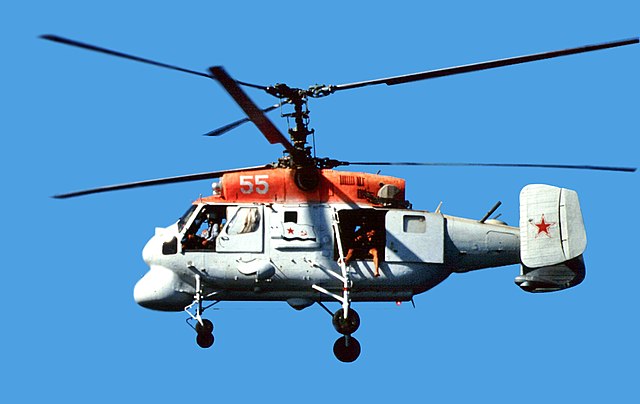
The proverbial Soviet ASW helicopter, used virtually on all cruisers (from 1965) until replacement by the Ka-27 Helix. Acceptance dated back from 1972, but the Ka-25 was produced and therefore tested since 1965. The demonstrator called Ka-20 first flew in 1961.
Characteristic with their tandem rotor and rear “H” tail. Could performe SAR missions as well as ASW patrol, and missile guidance relay over the horizon.
Armed with 1,900 kg (4,189 lb) of disposable stores, buoys, torpedoes and depht-charges, either conventional or nuclear, tactic. Preoduced to around 560, they were declined into a dozen variants and exported.
-Kamov Ka-27 “Helix” (1980)
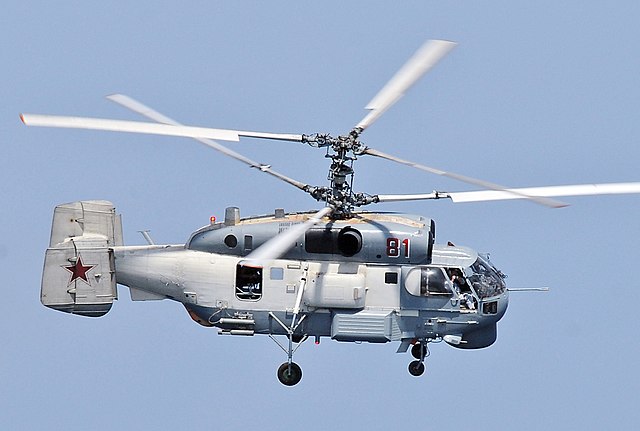
Same general design, but all-out improved. Declined into 21 versions, including the civilian ones, exported to nine countries (military version alone), production is still ongoing. Faster, with longer range, they carried an ASW torpedoes of the AT-1M, VTT-1, UMGT-1 Orlan, or APR-2 Yastreb type, 36 RGB-NM & RGB-NM-1 sonobuoys.
The assault Ka-29TB developed on the same basis, carried a GShG-7.62 machine gun, 30 mm 2A42 cannon and four external hardpoints, plus 6 troops.
-Mil-Mi 14 “Haze” (1980)
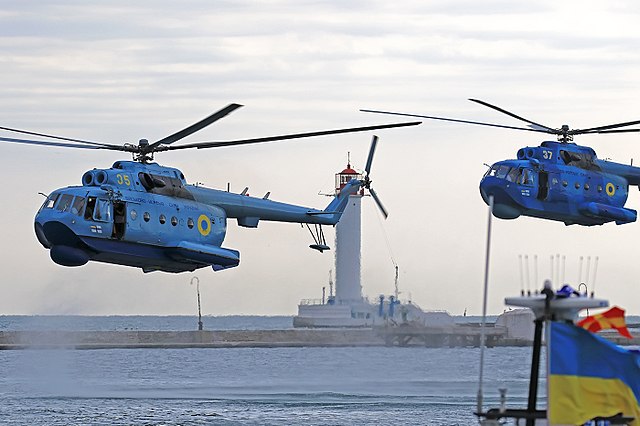
The amphibious Mi-14 is the only helicopter by Mil, the Russian land helicopter specialist to take sea going duties. It’s in a sense the the Soviet replica to the British Westland Sea King and French Aerospatiale Super Frelon. Ten variants, some under licence, exported to 15 countries, the Mi-14 first flew in September 1969 and was accepted for service in 1975. 230 were built, but they are likely decommissioned since 1997 but 44. Production revival has been estimated in an upgraded form. It could operate from the Moskva class, Kiev class and Kuznetsov which deck and accomodations are strong and large enough.
It should be added that for amphibious assault, in addition to large landing ships with helipads such as a ivan Rogov class, a large variety of land-based helicopters could be carried in operation, notably the uboquitous Mil-Mi-8 ‘Hip’, the feared Mi-24 ‘Hind’ mil-28 ‘Havoc’ and Ka-50 ‘Hokum’, to the exclusion of the massive Mi-3 and Mi-26. The Kuznetsov also regularly carries the navalized Kamov Ka-52K “Katran” attack helicopter for various sea operations. It was deployed for good use against piracy for example.
-Yakovlev Yak-38 “Forger” (1980)
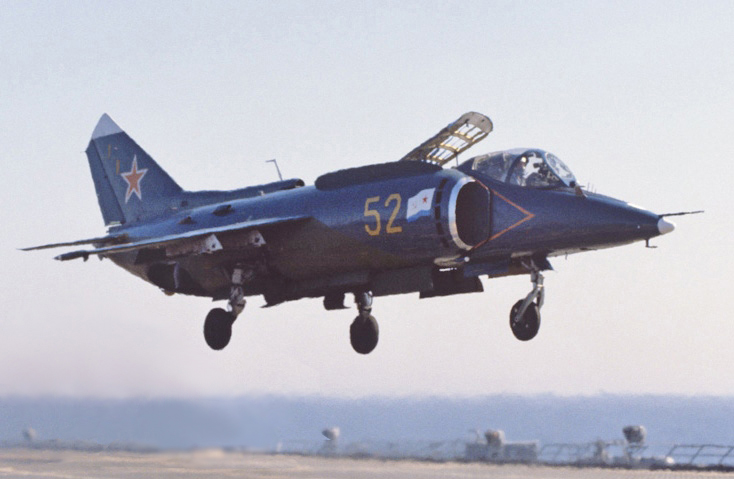
The Harrier-inspired Soviet VTOL was only used on the three Kiev class aircraft carrier hybrid cruisers. 230 were built in all, they first flew in 1971, production spanned 1971-1981. Engine development problems led to a plane that was subsonic and capable to carry a limited payload. A twin-seat version existed, quite different in apearance. Apart the Kiev ships, these were deployed on the Ro-Ro Nikolai Cherkasov for amphibious operation cover. This was one of the rare ships which deck was heat-treated. More on this plane when detailing the Kiev class in a future post.
-Mig-29K “Fulcrum-D” (2010)
First flight in 1981, but introduced from 2010. This version of the proverbial light Soviet dogfighter was developed to serve on the kuznetsov but also on the two carriers of the Indian Navy.
-Su-33 “Flanker-D” (1998)
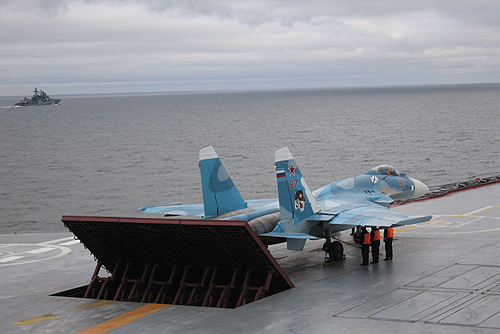
Development of the standard heavy fighter, part of the regular complement of the Kuznetsov. Officially introduced in 1998, and produced from 1987 to 1999. It was capable of carrying multiple missions with all sorts of payload, and in effect is the default multirole attack plane of this aicraft carrier, and only served with her, as only were 35 built.
-Su-25 UTG “Frogfoot-D” (1991)
A variant of the famous assault plane of the Soviet combat aviation, the UTG was developed specifically to operate on a mock version of the Kuznetsov. In practice, only ten were produced, to train pilots in takeoff and landing on a land-based simulated carrier deck, with a sloping ski-jump section and arrester wires. So this is an anecdotical plane, but which was seen in tests on the cruiser-carrier for possible evaluation of a permanent carrier-based assault variant.
Navalized Mig-29 KUB (two-seats variant) in exercises onboard the CATOBAR Admiral Kuznetsov.
Electronics
This chapter is in development.
A large part of it would be also covered in the upcoming Destroyer section, so only pure cruiser radar systems will be treated here.





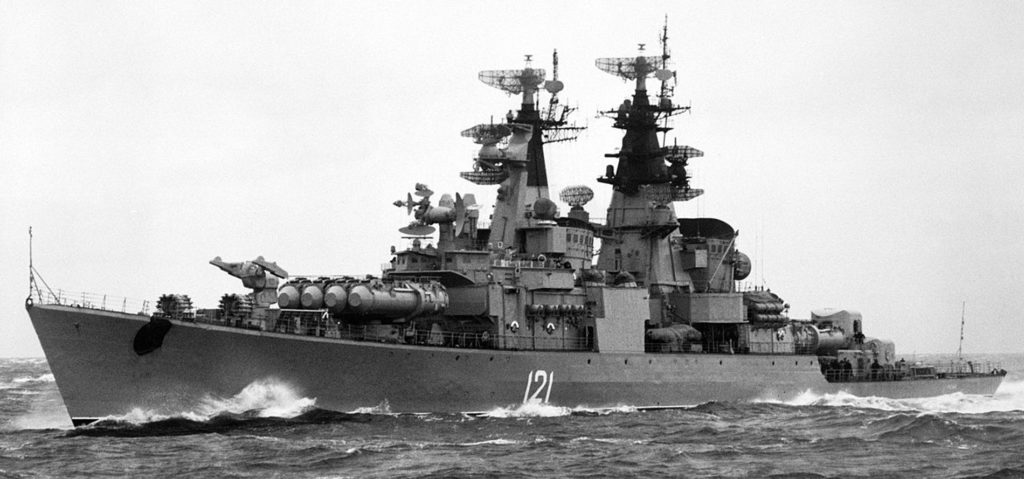
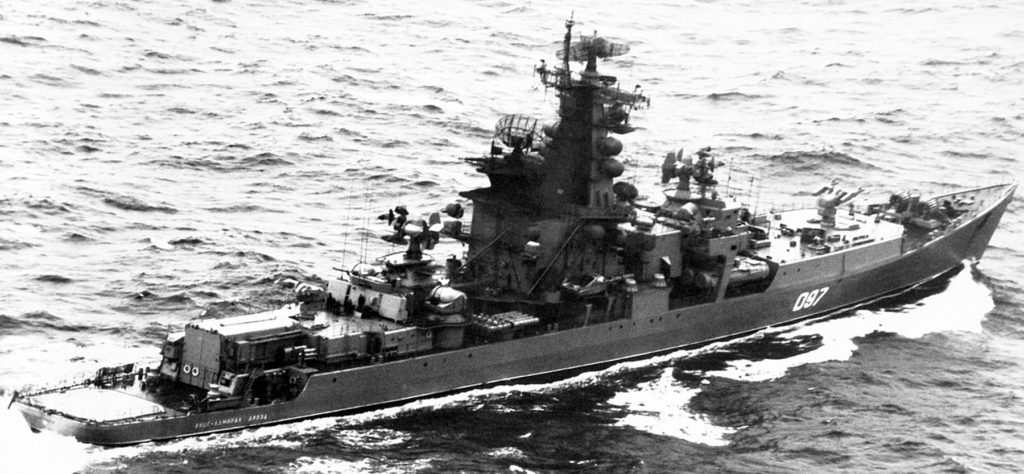
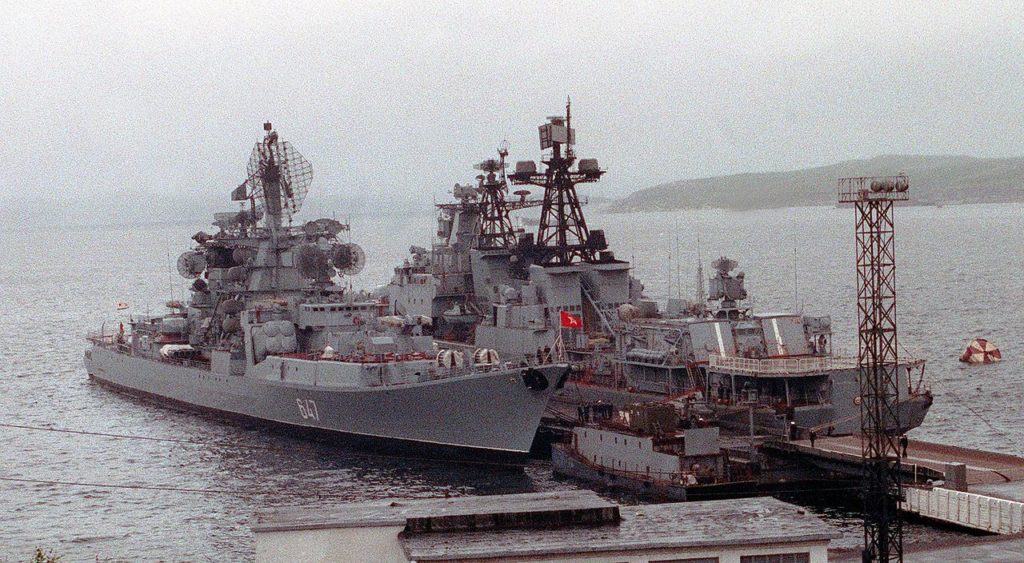

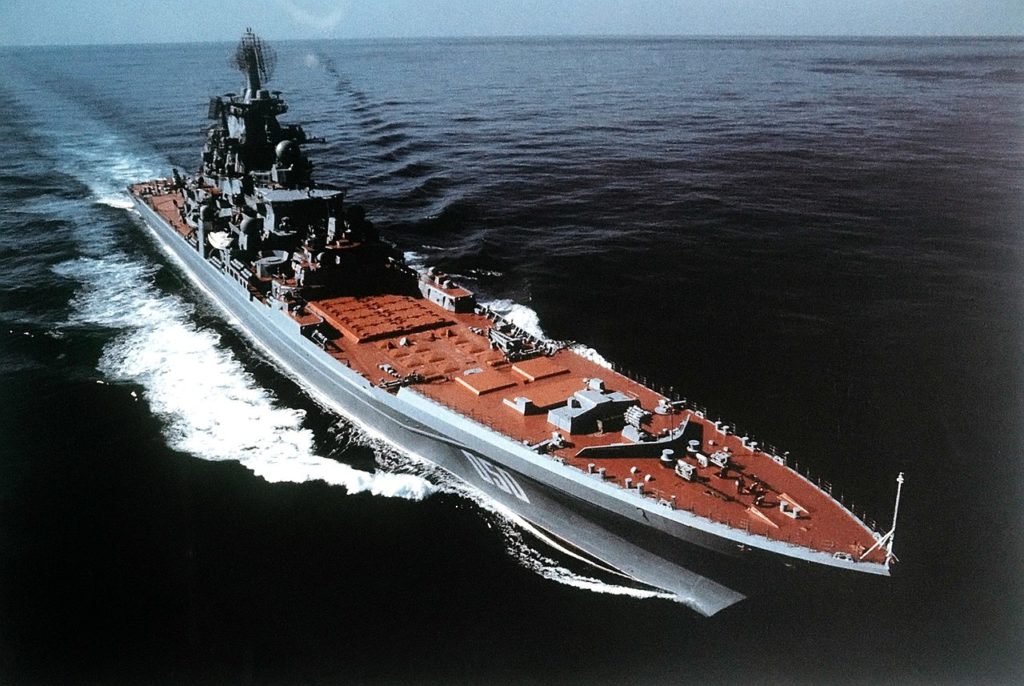
 Latest Facebook Entry -
Latest Facebook Entry -  X(Tweeter) Naval Encyclopedia's deck archive
X(Tweeter) Naval Encyclopedia's deck archive Instagram (@navalencyc)
Instagram (@navalencyc)





 French Navy
French Navy Royal Navy
Royal Navy Russian Navy
Russian Navy Armada Espanola
Armada Espanola Austrian Navy
Austrian Navy K.u.K. Kriegsmarine
K.u.K. Kriegsmarine Dansk Marine
Dansk Marine Nautiko Hellenon
Nautiko Hellenon Koninklije Marine 1870
Koninklije Marine 1870 Marinha do Brasil
Marinha do Brasil Osmanlı Donanması
Osmanlı Donanması Marina Do Peru
Marina Do Peru Marinha do Portugal
Marinha do Portugal Regia Marina 1870
Regia Marina 1870 Nihhon Kaigun 1870
Nihhon Kaigun 1870 Preußische Marine 1870
Preußische Marine 1870 Russkiy Flot 1870
Russkiy Flot 1870 Svenska marinen
Svenska marinen Søværnet
Søværnet Union Navy
Union Navy Confederate Navy
Confederate Navy Armada de Argentina
Armada de Argentina Imperial Chinese Navy
Imperial Chinese Navy Marinha do Portugal
Marinha do Portugal Mexico
Mexico Kaiserliche Marine
Kaiserliche Marine 1898 US Navy
1898 US Navy Sovietskiy Flot
Sovietskiy Flot Royal Canadian Navy
Royal Canadian Navy Royal Australian Navy
Royal Australian Navy RNZN Fleet
RNZN Fleet Chinese Navy 1937
Chinese Navy 1937 Kriegsmarine
Kriegsmarine Chilean Navy
Chilean Navy Danish Navy
Danish Navy Finnish Navy
Finnish Navy Hellenic Navy
Hellenic Navy Polish Navy
Polish Navy Romanian Navy
Romanian Navy Turkish Navy
Turkish Navy Royal Yugoslav Navy
Royal Yugoslav Navy Royal Thai Navy
Royal Thai Navy Minor Navies
Minor Navies Albania
Albania Austria
Austria Belgium
Belgium Columbia
Columbia Costa Rica
Costa Rica Cuba
Cuba Czechoslovakia
Czechoslovakia Dominican Republic
Dominican Republic Haiti
Haiti Hungary
Hungary Honduras
Honduras Estonia
Estonia Iceland
Iceland Eire
Eire Equador
Equador Iran
Iran Iraq
Iraq Latvia
Latvia Liberia
Liberia Lithuania
Lithuania Mandchukuo
Mandchukuo Morocco
Morocco Nicaragua
Nicaragua Persia
Persia San Salvador
San Salvador Sarawak
Sarawak Uruguay
Uruguay Venezuela
Venezuela Zanzibar
Zanzibar Warsaw Pact Navies
Warsaw Pact Navies Bulgaria
Bulgaria Hungary
Hungary

 Bundesmarine
Bundesmarine Dutch Navy
Dutch Navy Hellenic Navy
Hellenic Navy Marina Militare
Marina Militare Yugoslav Navy
Yugoslav Navy Chinese Navy
Chinese Navy Indian Navy
Indian Navy Indonesian Navy
Indonesian Navy JMSDF
JMSDF North Korean Navy
North Korean Navy Pakistani Navy
Pakistani Navy Philippines Navy
Philippines Navy ROKN
ROKN Rep. of Singapore Navy
Rep. of Singapore Navy Taiwanese Navy
Taiwanese Navy IDF Navy
IDF Navy Saudi Navy
Saudi Navy Royal New Zealand Navy
Royal New Zealand Navy Egyptian Navy
Egyptian Navy South African Navy
South African Navy






























 Ukrainian Navy
Ukrainian Navy dbodesign
dbodesign